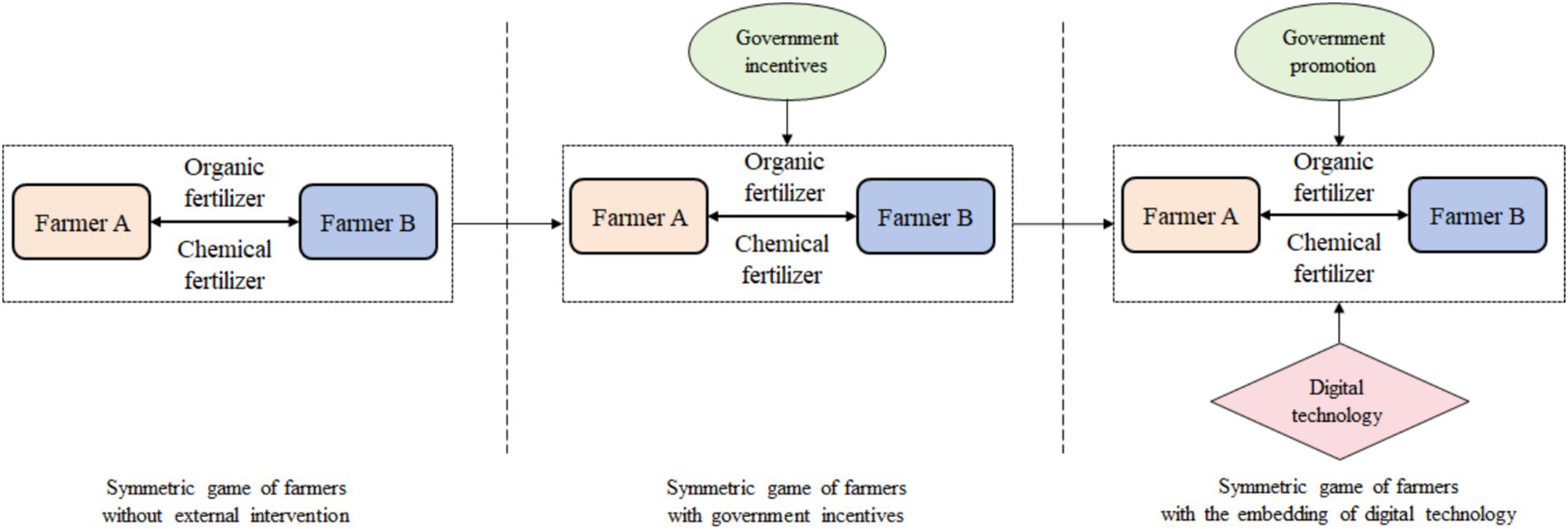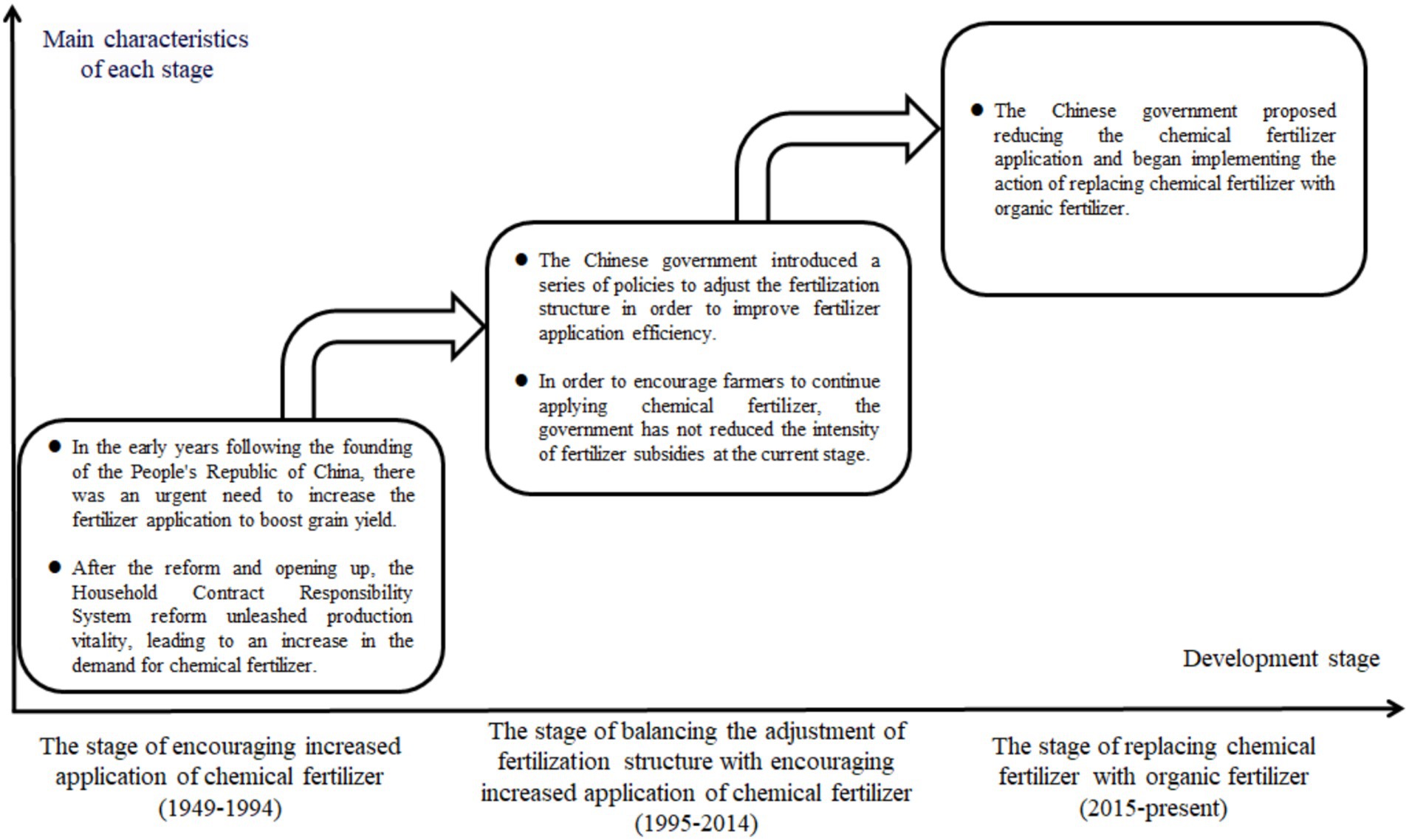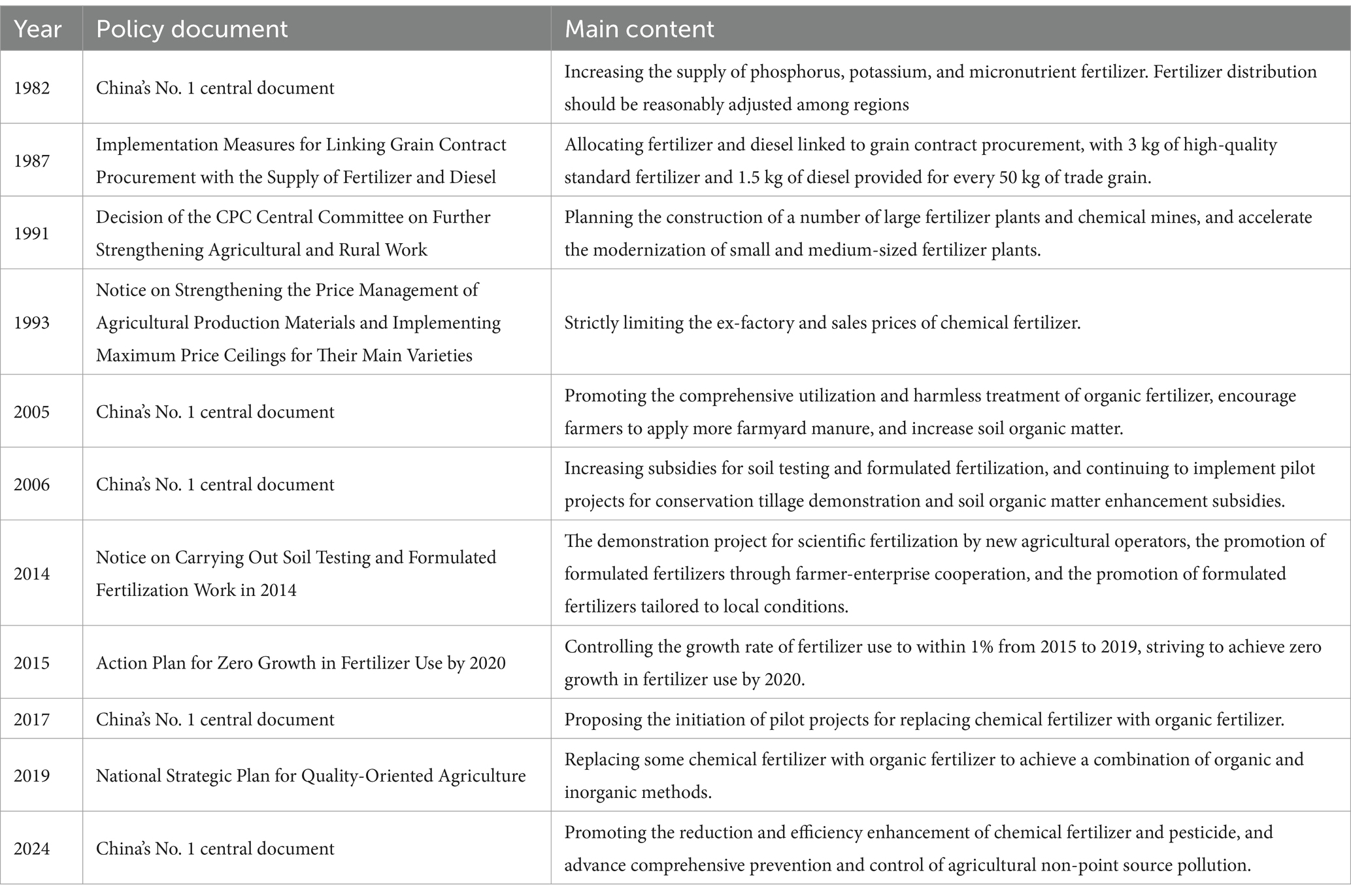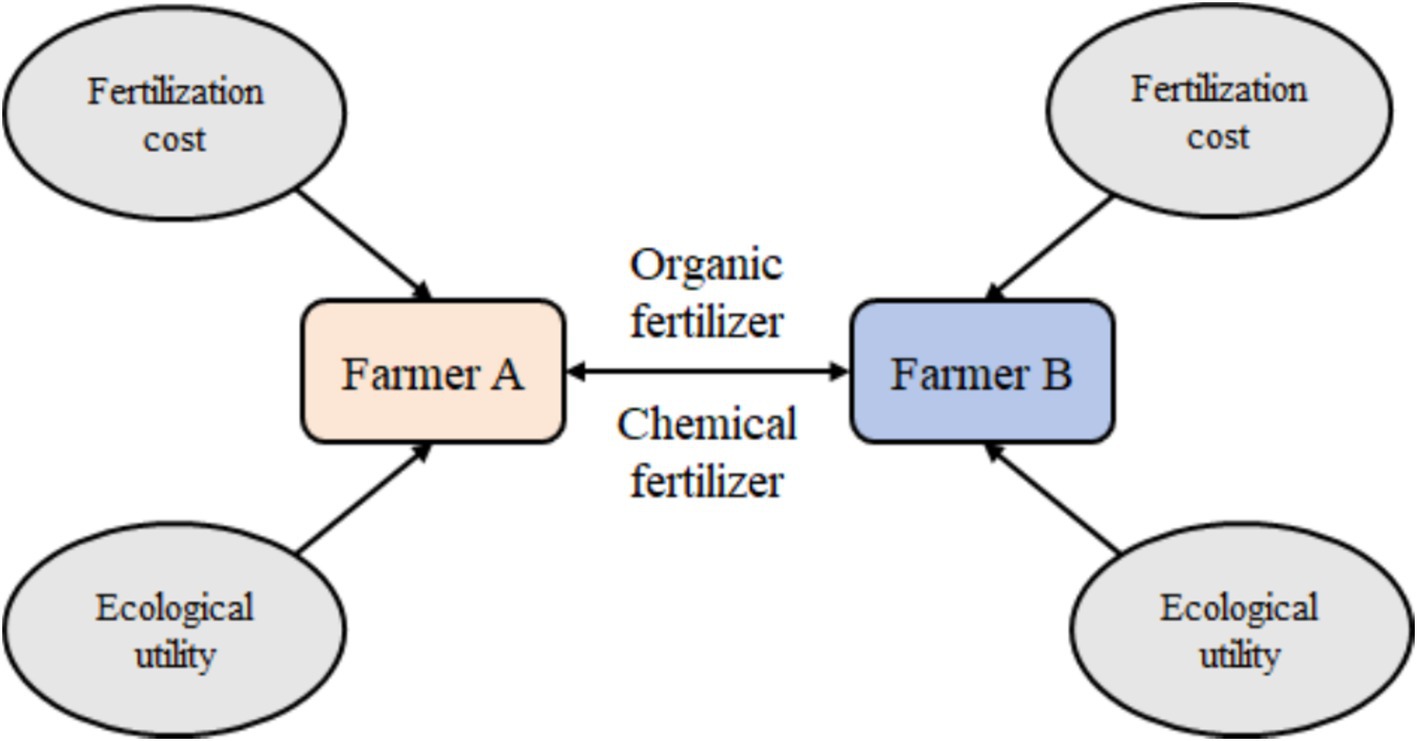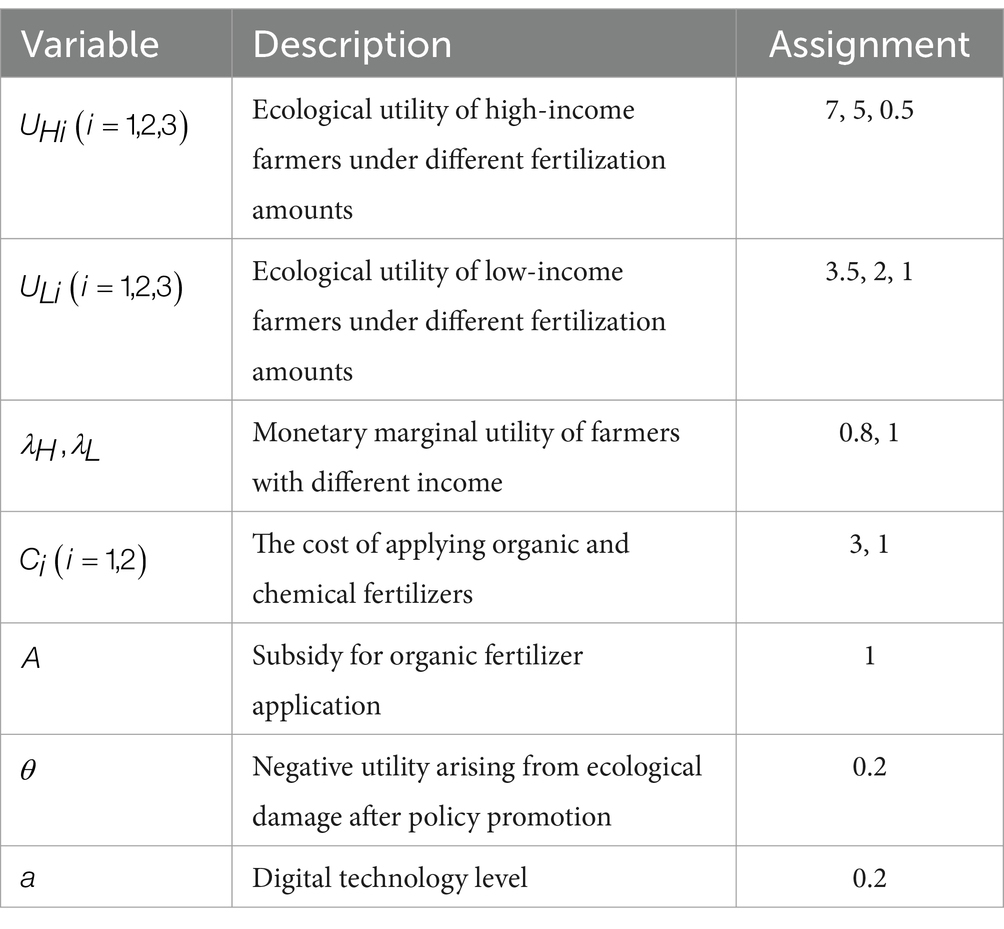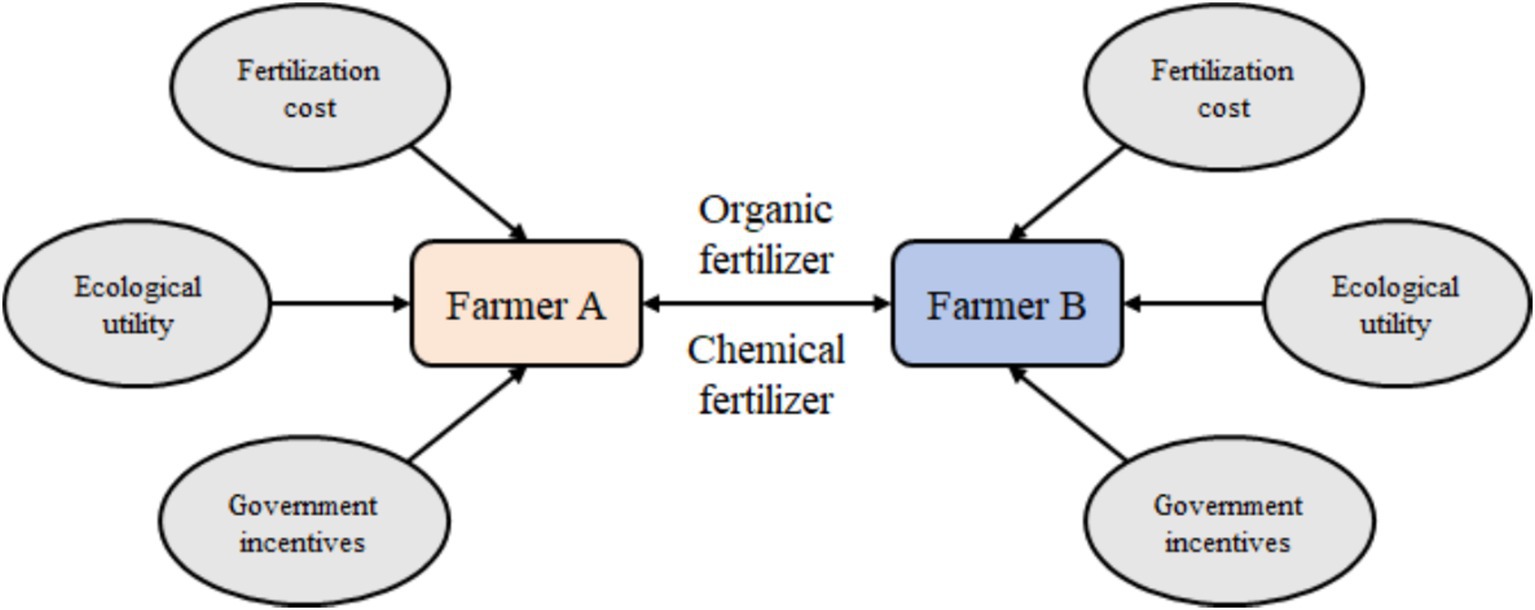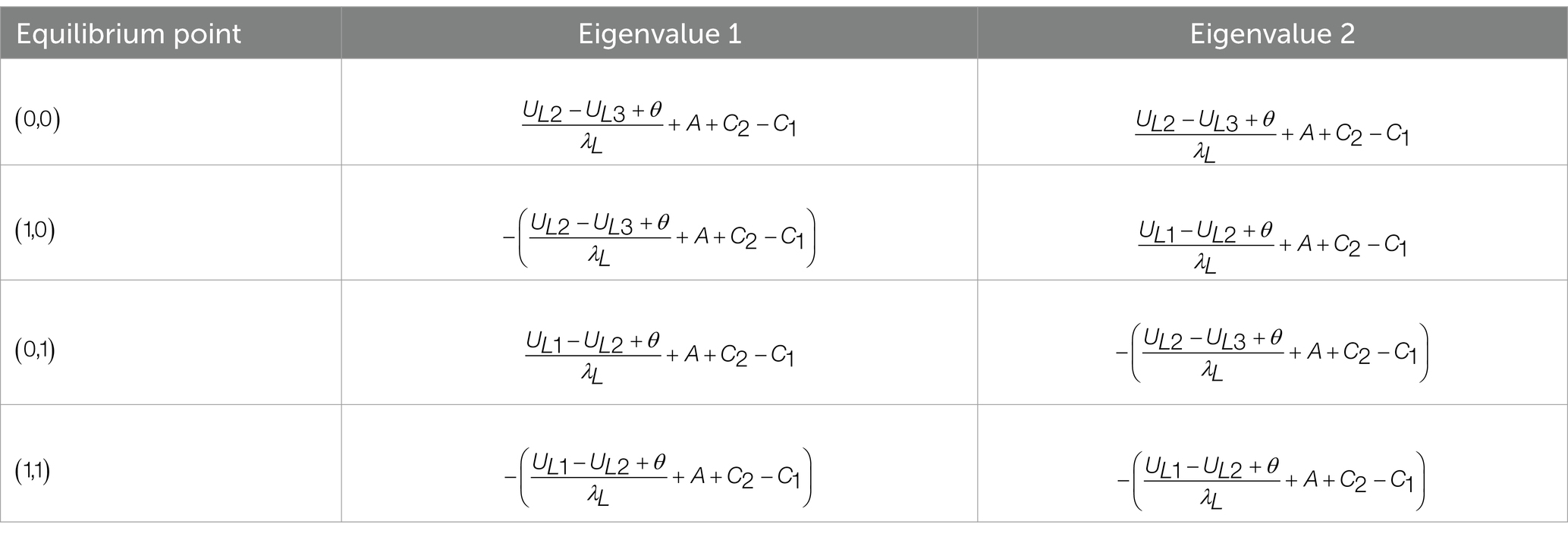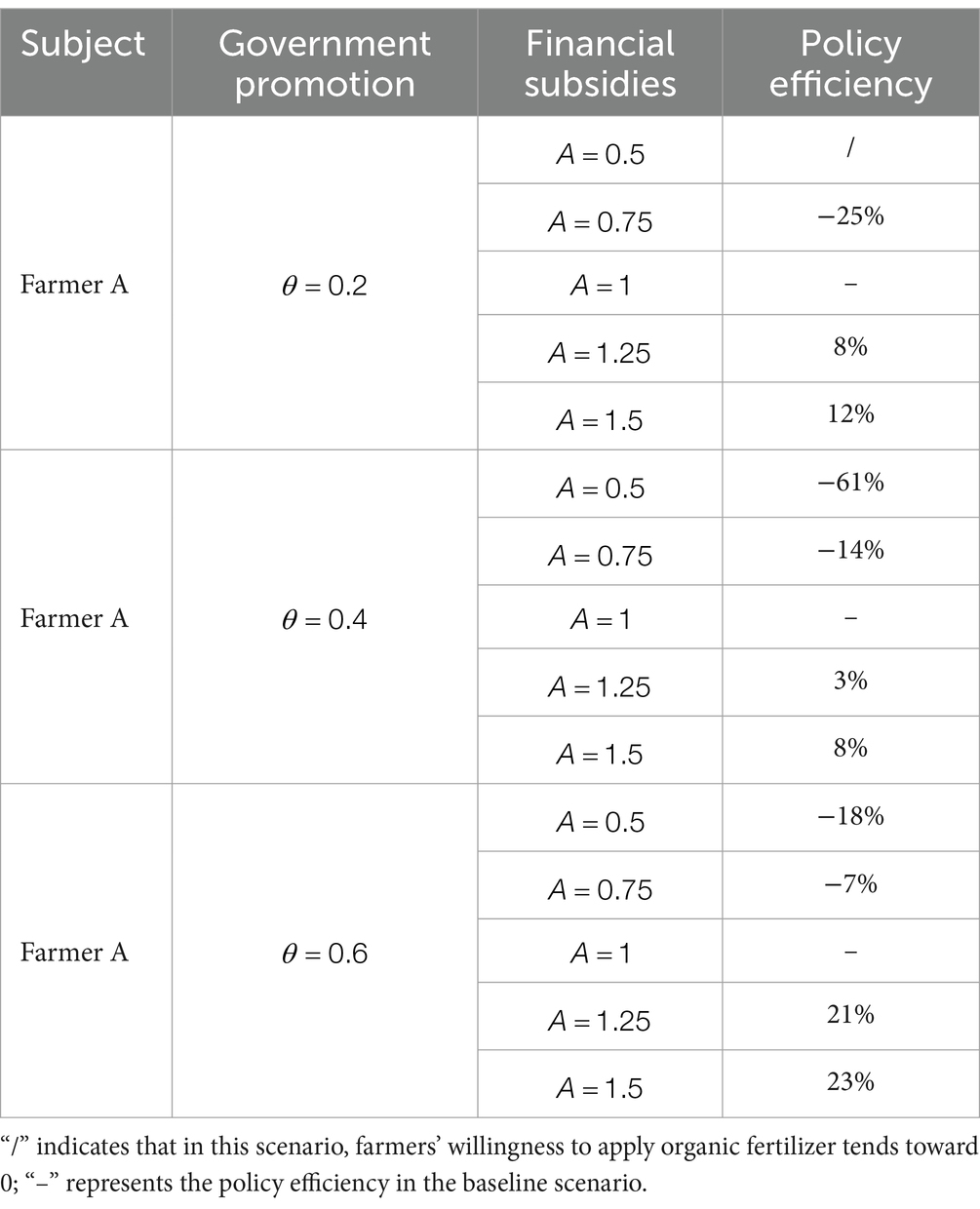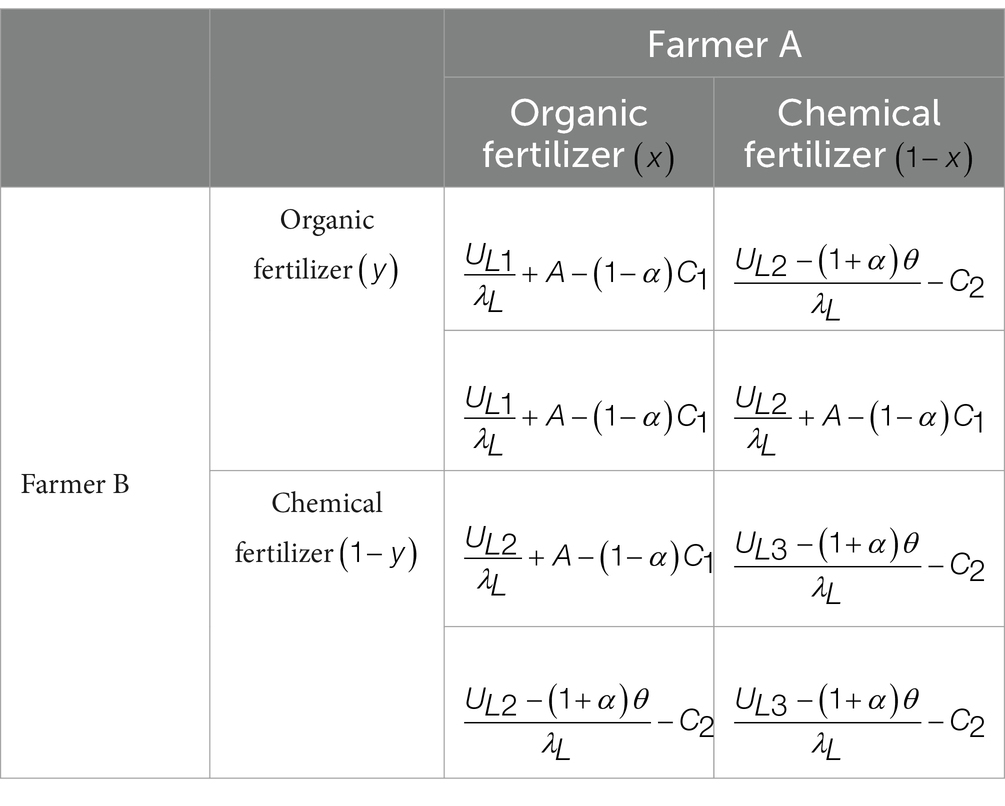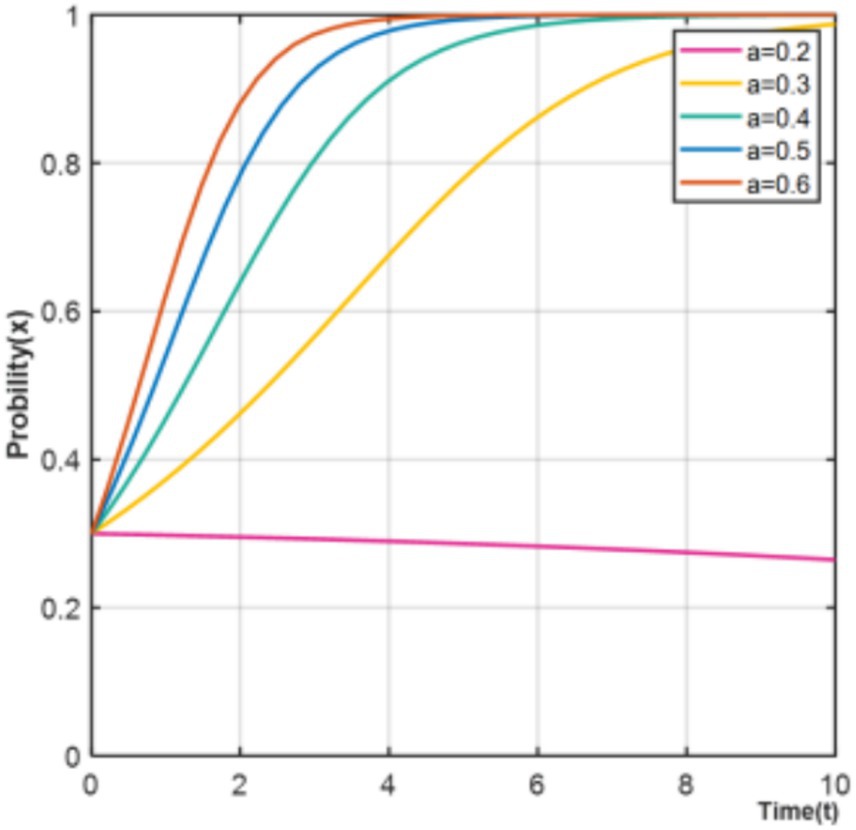- 1Business School, Wenzhou University, Wenzhou, China
- 2Institute of Digital Intelligence Technology, Wenzhou Vocational College of Science and Technology, Wenzhou, China
Introduction: The replacement of chemical fertilizer with organic fertilizer is an important way to improve agricultural non-point source pollution and achieve green agricultural development. However, the current adoption rate of organic fertilizer among farmers is relatively low, and the economic and environmental benefits of organic fertilizer are difficult to realize.
Methods: Based on the assumption of bounded rationality and combining evolutionary game theory, this paper constructs a symmetric game model of farmers under three scenarios: no external intervention, government incentives, and digital technology integration, deeply exploring the strategy choices of farmers and the effectiveness of intervention measures in different scenarios.
Results and discussion: Income levels have a differentiated impact on farmers’ learning and imitation behaviors. Government subsidies can significantly increase the willingness to apply organic fertilizer in the short term, but due to the heavy financial burden, it is difficult to sustain in the long run. Policy promotion can strengthen farmers’ moral constraints, but the effect of moral constraints is limited due to the long-term nature of ecological moral cultivation. In the absence of government subsidies, developing digital technology can also promote adopting organic fertilizer. The breakthrough of this paper lies in integrating behavioral insights, incentive policies, and digital technologies to comprehensively analyze the influencing factors of organic fertilizer application, and explore how to encourage farmers to adopt organic fertilizer in the absence of subsidies. This contributes to the formulation and improvement of organic fertilizer subsidy policies, with both theoretical and practical significance for enhancing agricultural competitiveness and achieving the green transformation of agriculture.
1 Introduction
Fertilizers are essential production materials for ensuring food production and achieving green agricultural development (He et al., 2020). However, the long-term excessive and inefficient use of fertilizer has caused serious agricultural non-point source pollution issues (Savci, 2012; Guo and Wang, 2021). Governments around the world have introduced policies to limit the use of chemical fertilizers: the U.S. Natural Resources Conservation Service launched the “Organic Agriculture Environmental Incentives Program” to provide production guidance and technical services to organic producers, offering financial support to farmers, with a maximum subsidy of $20,000 per year. The European Union introduced the Water Framework Directive, aiming to comprehensively regulate water resources, particularly to address nitrogen, phosphorus, and many other chemical pollutants from pesticides, fertilizers, and heavy metals. Japan follows the natural farming scientific model, using the “nature-substance” cycle mechanism to reduce pesticide and fertilizer use. Since Chinese government proposed the initiative of “reduction and efficiency enhancement of chemical fertilizer” in 2015, by 2022, the amount of agricultural fertilizer application and grain yield in China were 50.79 million tons and 686.53 million tons, respectively. The former decreased by 16% compared to 2015, while the latter increased by 4% compared to 2015.1 Although the initiative has achieved certain results, the agricultural non-point source pollution and food safety issues caused by the long-term chemical fertilizer application remain significant factors constraining green agricultural development (Shuqin and Fang, 2018). To this end, the 2024 “China’s No. 1 Central Document” once again emphasized the need to “solidly promote the reduction and efficiency enhancement of chemical fertilizer and pesticide, and advance comprehensive prevention and control of agricultural non-point source pollution.”
Organic fertilizer, as environmentally friendly fertilizer, mainly include manure-based fertilizer, compost, green manure, and mixed fertilizer. Their main characteristic is that they convert organic matter into nutrients beneficial for plant growth through natural degradation. Promoting the standardized production and scientific use of organic fertilizer plays an irreplaceable role in improving crop quality and yield, reducing environmental pollution, and achieving resource recycling (Maroušek et al., 2016). With the deepening of research, the application of biochar has provided an important breakthrough direction for promoting the replacement of chemical fertilizer with organic fertilizer. As an effective soil amendment, biochar can significantly reduce nitrate levels in crops, improve soil structure, and enhance the soil’s ability to retain water and nutrients, thereby increasing the fertility of organic fertilizer (Maroušek et al., 2018). In the future, with the reduction of production costs and the improvement of technologies, biochar will play an increasingly important role in agricultural production (Marousek et al., 2024). In recent years, nutrient recovery has become a key component of sustainable agriculture, focusing on recovering nutrients from agricultural waste, urban organic waste, and industrial by-products to achieve a circular agricultural economy. Research has shown that recovering phosphorus from waste not only helps reduce agriculture’s reliance on fertilizer but also provides significant economic returns (Maroušek and Gavurová, 2022; Stávková and Maroušek, 2021). Alternative biowaste valuation methods provide a quantitative basis for the promotion of organic fertilizer. These methods not only effectively assess the environmental and economic benefits but also help in understanding the long-term value and potential of converting biowaste into organic fertilizer (Maroušek et al., 2023, 2020). Against the backdrop of rising fossil fuel prices, the production costs of chemical fertilizer are continually increasing (Vochozka et al., 2020a,b). The replacement of chemical fertilizer with organic fertilizer has become a new norm to alleviate the conflict between economic benefits and environmental protection and achieve green transformation and sustainable development in agriculture. However, the adoption rate of organic fertilizer among farmers is not high (Yu et al., 2019). Understanding the evolutionary mechanism of farmers’ adoption of organic fertilizer is of great significance for advancing green agricultural development.
Existing research has primarily focused on the willingness and behavior of applying organic fertilizer, and have produced a large number of innovative findings. Overall, the factors influencing farmers’ fertilization strategies are complex and diverse. Individual characteristics such as a farmers’ gender, age, education level, and whether they have had special experiences can all affect the replacement of chemical fertilizer with organic fertilizer (Xie et al., 2021). Family endowments such as farming intentions, income levels, and land management scale also influence farmers’ fertilization strategies (Fang et al., 2021). As research has deepened, some scholars have begun to explore the influence of psychological factors such as risk perception and ecological awareness on farmers’ decision-making from a behavioral economics perspective. For instance, risk aversion may lead farmers to prefer applying chemical fertilizer, which they are proficient in and can bring stable returns. Weak environmental awareness causes farmers to overlook environmental protection and makes it difficult to recognize the ecological benefits of organic fertilizer, thereby reducing their willingness to apply organic fertilizer (Chen et al., 2018; Wang et al., 2021). The learning and imitation behaviors among farmers can also influence their fertilization preferences because they may choose group strategies due to the demonstration effect and herd mentality (Tian et al., 2022). From the perspective of external environmental characteristics, factors such as financial subsidies (organic fertilizer subsidies), government promotion, and advances in digital technology all have a significant positive impact on farmers’ organic fertilizer application (Wang et al., 2018; Li et al., 2024).
However, existing research tends to focus on individual factors, such as farmer behavior and exogenous incentives, that influence organic fertilizer use, lacking a holistic analytical framework. On the one hand, most studies concentrate on how to increase farmers’ overall willingness to apply organic fertilizer, but income differences can affect farmers’ risk tolerance, technology acceptance, and motivations for learning and imitation. High-income farmers generally have better economic foundations and educational levels, making them more likely to adopt emerging technologies. In contrast, low-income farmers, due to limited funds, are more sensitive to risks and face more challenges during technology adoption. The differentiated impact of income levels is often overlooked by scholars. On the other hand, financial subsidies and government promotion are effective incentives for encouraging organic fertilizer application, yet they tend to have varying policy effects. Existing studies usually focus on a single policy, lacking comparative analysis between them. Moreover, due to the financial pressure caused by subsidy policies, there may be cases where subsidies are reduced if the policies fail to achieve the desired outcomes. How can farmers’ willingness to apply organic fertilizer be ensured in this scenario? This issue is largely ignored in current research. Additionally, in the context of rapid digital economic development, digital technologies, with their low cost, high efficiency, and precision, can effectively promote organic fertilizer technology. Although some scholars have begun to study the impact of digital technology on agricultural technology extension (Singh et al., 2023; Xu et al., 2023; Du et al., 2023), there is still a lack of theoretical analysis on how digital technologies affect the replacement of chemical fertilizer with organic fertilizer.
The excessive use of chemical fertilizer has led to a series of environmental issues, including soil degradation, water pollution, and greenhouse gas emissions, which not only constrain the sustainability of agricultural production but also incur significant economic costs. Although governments worldwide have implemented corresponding fertilizer management policies, the rapid effectiveness and low cost of chemical fertilizer make it difficult to achieve the desired outcomes. Organic fertilizer, as a green production technology, combines both environmental and economic benefits. Exploring the feasibility of replacing chemical fertilizer with organic fertilizer has become increasingly urgent and necessary. From the investors’ perspective, profitability is a key factor in evaluating investment projects. They not only focus on short-term returns but also place greater emphasis on the project’s long-term benefits and risk levels (Pavolova et al., 2021; Akbari et al., 2021). In the agriculture sector, the input of production factors is often influenced by market returns. Only when organic fertilizer technology demonstrates long-term profitability and provides stable income for farmers are they more motivated to overcome production inertia and adopt it. However, due to the high costs of organic fertilizer and the uncertainty of its market returns, the adoption rate of organic fertilizer is generally low (Huang et al., 2019). Therefore, increasing the adoption rate of organic fertilizer is a crucial prerequisite for achieving coordinated economic and environmental development. Based on the above analysis, this paper aims to address the following questions:
• What is the effect of learning and imitation behaviors on farmers with different incomes?
• How do external factors (government incentives and digital technology) influence farmers’ strategy choices and alter the system’s steady state?
• How to encourage farmers to apply organic fertilizer in situations with low or even zero subsidies?
To address above questions, this paper first constructs a symmetric game model of farmers without external intervention. By adjusting the initial willingness, this paper analyzes the impact of learning and imitation behaviors on applying organic fertilizer. Subsequently, this paper considers the impact of government incentives on farmers’ fertilization strategies. Through partial equilibrium strategy analysis, stability analysis, and sensitivity analysis of key influencing factors, this paper discusses the effectiveness of financial subsidies and government promotion. Based on this, this paper further discusses how digital technology influence farmers’ fertilization strategies, aiming to provide a more comprehensive perspective for promoting organic fertilizer. The symmetric game model of farmers under the three scenarios is shown in Figure 1.
The potential marginal contributions of this paper are mainly reflected in the following three aspects: firstly, this paper analyzes the impact of chemical fertilizer on the ecological environment and introduces the concept of “ecological utility.” Based on this, it sets differentiated ecological utility curves for farmers with different income levels, and then analyzes the influence of ecological utility on applying organic fertilizer. Secondly, the existing research mostly adopts qualitative and descriptive statistical methods to study issues related to the replacement of chemical fertilizer with organic fertilizer (Fang et al., 2021; Yang et al., 2020; Chen et al., 2022), but this paper explores the strategic evolution of farmers from a dynamic perspective. By constructing symmetric game models of farmers under different scenarios, the paper comprehensively analyzes the evolution of farmers’ fertilization strategies in three contexts: no external intervention, government incentives, and the embedding of digital technology, making the research conclusions more relevant to the current situation. Thirdly, financial subsidies are an important incentive to promote organic fertilizer. However, maintaining high subsidies over the long term can impose a financial burden on the government, so how to promote farmers to apply organic fertilizer in a low-subsidy or even zero-subsidy scenario? By comparing the mechanisms of financial subsidies and digital technology, this paper analyzes the impact of digital technology on farmers’ fertilization strategies in the context of zero financial subsidies.
The remaining content of this paper is organized as follows: In Section 2, we outline the evolution of China’s fertilizer regulation policies. Section 3 describes the theoretical framework and ecological utility curve. Section 4 constructs evolutionary game models under three different scenarios and conducts sensitivity analysis of key influencing factors. Section 5 further discusses the effects of government incentives and digital technology. The implications and conclusions are explained in Section 6.
2 Evolution of China’s fertilizer regulation policies
Fertilizer, often referred to as the “food for crops,” plays a crucial role in increasing agricultural production and farmers’ income. However, the extensive application of fertilizer has also resulted in serious environmental pollution problems. To this end, Chinese government has made adaptive adjustments to fertilizer policies. This paper, considering the key milestones in China’s fertilizer policy changes, divides the evolution of fertilizer policies into three stages: the stage of encouraging increased application of chemical fertilizer (1949–1994), the stage of balancing the adjustment of fertilization structure with encouraging increased application of chemical fertilizer (1995–2014), and the stage of replacing chemical fertilizer with organic fertilizer (2015–present), as shown in Figure 2.
2.1 The stage of encouraging increased application of chemical fertilizer (1949–1994)
In the early years after the founding of the People’s Republic of China, China faced severe food shortages and there was an urgent need to increase the chemical fertilizer application to boost grain yield. On the one hand, China increased fertilizer supply by investing heavily in the construction of large fertilizer factories and provided subsidies for fertilizer production materials, prices, and electricity. China also imported fertilizer from abroad to meet domestic demand when necessary. On the other hand, the agricultural sector promoted chemical fertilizer through agricultural machinery extension stations, raising farmers’ awareness and guiding them applying fertilizer. As a result, the amount of fertilizer application increased from 1 million tons in the 1950s to 10 million tons by the late 1970s. However, due to limited supply capacity of chemical fertilizer, organic fertilizer remained the primary source of fertilizer input in China for a considerable period.
After the reform and opening up, the Household Contract Responsibility System reform unleashed production vitality, leading to an increase in the demand for chemical fertilizer. The 1982 “China’s No. 1 Central Document” explicitly stated, “Actively increasing the supply of phosphorus, potassium, and micronutrient fertilizer,” while also emphasizing that “fertilizer distribution should be reasonably adjusted among regions, increasing supply to areas with medium and low fertility.” To further increase the supply of fertilizer and boost farmers’ enthusiasm for applying fertilizer, China implemented a dual pricing system for fertilizer in 1985. The “Decision of the CPC Central Committee on Further Strengthening Agricultural and Rural Work” in 1991 clearly stated, “Planning the construction of a number of large fertilizer factories and chemical mines, and accelerate the modernization of small and medium-sized fertilizer factories.” At the same time, various preferential policies were provided for fertilizer production, such as tax incentives and reduced railway freight rates, effectively increasing the supply of fertilizer. In 1987, the central government issued the “Implementation Measures for Linking Grain Contract Procurement with the Supply of Fertilizer and Diesel,” stipulating that, Allocating some fertilizer and diesel linked to grain contract procurement, with 3 kg of high-quality standard fertilizer and 1.5 kg of diesel provided for every 50 kg of trade grain. To curb the rapid rise in prices of chemical fertilizer, the State Council issued the “Notice on Strengthening the Price Management of Agricultural Production Materials and Implementing Maximum Price Ceilings for Their Main Varieties” in 1993, strictly limiting the ex-factory and sales prices of chemical fertilizer. By 1994, China’s fertilizer application amount reached 33.179 million tons, approximately 3.75 times that of 1978.
During this stage, although some documents occasionally mentioned the rational application of chemical fertilizer, in the context of grain yield and addressing food security, such documents did not raise awareness of the rational application of chemical fertilizer.
2.2 The stage of balancing the adjustment of fertilization structure with encouraging increased application of chemical fertilizer (1995–2014)
As fertilizer application increased, soil quality significantly declined, and fertilizer application efficiency remained low. To this end, the Chinese government introduced a series of policy measures to adjust the fertilization structure. In 1995, the Ministry of Agriculture launched the “Fertile Soil Plan” nationwide, focusing on the production of organic fertilizer. The plan required that each hectare of land receive no less than 30 tons of organic fertilizer annually, with an annual increase of 5%.2 The 2005 “China’s No. 1 Central Document” proposed, “Promoting the comprehensive utilization and harmless treatment of organic fertilizer, encourage farmers to apply more farmyard manure, and increase soil organic matter.” In the following 4 years (2006–2009), the “China’s No. 1 Central Document” continued to advocate for the promotion of the “Fertile Soil Plan.” Additionally, it encouraged farmers to grow green manure and return straw to the fields. Starting from June 1, 2008, taxpayers producing and selling organic fertilizer products were exempted from value-added tax (VAT). In addition to organic fertilizer, the Chinese government also encouraged farmers to adopt slow-release fertilizers.
To reduce blind and excessive fertilization, soil testing and formulated fertilization were initiated nationwide in 2005. The 2006 “China’s No. 1 Central Document” proposed, “Increasing subsidies for soil testing and formulated fertilization, and continuing to implement pilot projects for conservation tillage demonstration and soil organic matter enhancement subsidies.” Soil testing and formulated fertilization transitioned from a departmental initiative to a government action, with increasing subsidies gradually provided to support these practices. To address the “last mile” issue of soil testing and formulated fertilization, the Ministry of Agriculture issued the “Opinions on Further Promoting Enterprise Participation in Soil Testing and Formulated Fertilization” in 2008, encouraging enterprises to participate in and guide farmers in formulated fertilization. In 2012, the nationwide pilot action for the promotion of formulated fertilizers through farmer-enterprise cooperation was further implemented. In 2014, the Ministry of Agriculture and the Ministry of Finance issued the “Notice on Carrying Out Soil Testing and Formulated Fertilization Work in 2014,” which proposed initiatives such as the demonstration project for scientific fertilization by new agricultural operators, the promotion of formulated fertilizers through farmer-enterprise cooperation, and the promotion of formulated fertilizers tailored to local conditions. By the end of 2014, the central government had invested a total of 7.8 billion yuan to promote soil testing and formulated fertilization. The cumulative reduction in unreasonable fertilization exceeded 10 million tons.3
At the same time, to ensure the supply of fertilizer and encourage farmers to apply them, the Chinese government did not reduce the intensity of fertilizer subsidies during this stage. In 2003 and 2006, the National Development and Reform Commission (NDRC) required all industrial and commercial entities, except for the fertilizer industry, to increase electricity prices. In 1998, the Chinese government implemented preferential railway freight rates for fertilizer transportation and exempted it from the railway construction fund. Although fertilizer transportation prices were moderately increased in 2009, the exemption from the railway construction fund continued. Moreover, subsidies for fertilizer transportation in China increased from 6.37 billion yuan in 2003 to 7.91 billion yuan in 2011. Additionally, fertilizer products were exempted from value-added tax (VAT), with related VAT subsidies amounting to $871 million in 2004 and $676.2 million in 2010 (Li et al., 2014).
2.3 The stage of replacing chemical fertilizer with organic fertilizer (2015–present)
Although adjusting farmers’ fertilization structures can reduce blind fertilization and improve fertilizer application efficiency, the amount of fertilizer applied by farmers continued to increase, reaching its peak in 2016 at approximately 59.84 million tons, with an average application rate of 328.65 kg/ha, far exceeding the global average of 120 kg/ha. In response, China initiated the fertilizer reduction action. In 2015, the Ministry of Agriculture issued the “Action Plan for Zero Growth in Fertilizer Use by 2020,” which explicitly proposed controlling the growth rate of fertilizer application to within 1% from 2015 to 2019, striving to achieve zero growth in fertilizer application by 2020, and initially establishing a scientific fertilization management and technology system. At the same time, considering the ample organic fertilizer resources and the relatively low proportion of organic fertilizer application, China began implementing the action to replace chemical fertilizer with organic fertilizer. In May 2016, the State Council issued the “Soil Pollution Prevention and Control Action Plan,” which proposed “Encouraging farmers to increase the organic fertilizer application and reduce the chemical fertilizer application.” The 2017 “China’s No. 1 Central Document” explicitly proposed for the first time the initiation of pilot projects for replacing chemical fertilizer with organic fertilizer.4 In February of the same year, the Ministry of Agriculture issued the “Action Plan for Replacing Chemical Fertilizer with Organic Fertilizer in Fruits, Vegetables, and Tea,” selecting 100 key counties (cities, districts) for fruits, vegetables, and tea to carry out demonstration projects for replacing chemical fertilizer with organic fertilizer. Each county was subsidized with 10 million yuan. In 2018, an additional 50 pilot counties were added, and the crop selection expanded from fruits, vegetables, and tea to include crops with significant fertilizer-saving potential, such as strawberries, mangoes, and pears. The “National Strategic Plan for Quality-Oriented Agriculture (2018–2022)” released in 2019 proposed “replacing some chemical fertilizer with organic fertilizer to achieve a combination of organic and inorganic methods.” Additionally, it further selected 175 counties to carry out the replacement of chemical fertilizer with organic fertilizer in fruits, vegetables, and tea, and 300 counties to implement fertilizer reduction and efficiency improvement. In 2020, the central government further improved the pilot support policies. These improvements included encouraging new agricultural operating entities to lead small farmers in participating in the organic fertilizer replacement pilot projects. In terms of support methods, the focus was on government procurement of services and technical subsidies, vigorously promoting the purchase of services from socialized service organizations for the organic fertilizer application in fields (see Table 1).
3 Theoretical analysis
3.1 Analytical framework based on evolutionary game theory
Evolutionary game theory is a broad approach to studying the interaction and strategic choices of agents. It establishes evolutionary game models centered on replicator dynamics equations and evolutionary stable states, which, respectively, represent the stable state of evolutionary games and the process of dynamically converging to such a stable state (Zhao et al., 2024). Compared to the static equilibrium of traditional game theory, evolutionary game theory addresses the issues of bounded rationality and learning mechanisms. It provides an effective mathematical model for predicting agents’ behavior choices and serves as a powerful tool for analyzing strategy evolution of individuals in complex systems (Coninx et al., 2018; Xie et al., 2018). Whether farmers choose to replace chemical fertilizer with organic fertilizer is influenced by a combination of factors, including internal factors such as herd mentality, as well as external factors such as government incentives and digital technology. Evolutionary game theory emphasizes the impact of interactions between groups and environmental changes on agents’ strategies (Friedman, 1991). Using evolutionary game theory to analyze the replacement of chemical fertilizer with organic fertilizer aligns well with practical logic. Therefore, this paper proposes the following analytical framework based on evolutionary game theory, as shown in Figure 3.
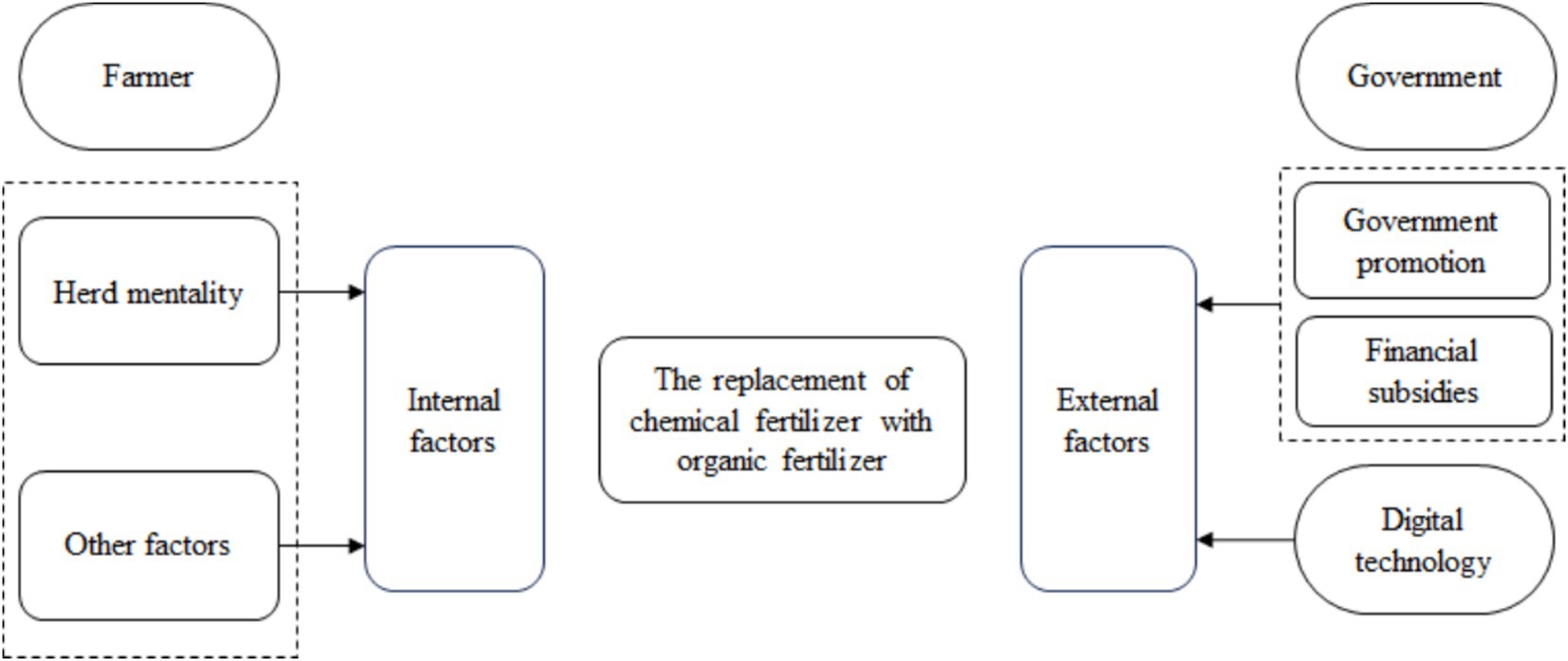
Figure 3. Analytical framework of factors influencing replacement of chemical fertilizer with organic fertilizer.
3.1.1 Herd mentality
A fundamental aspect of evolutionary game theory is that individuals achieve changes in group behavior through dynamic processes such as learning, imitation, and mutation (Roca et al., 2009). Due to bounded rationality and information asymmetry, farmers find it difficult to accurately assess the costs and benefits of different fertilization strategies, and blindly changing production decisions carries significant risks. In uncertain situations, learning and imitation can partially replace rational calculation (Tang and Song, 2015). When some farmers choose to apply organic fertilizer and achieve significant increases in their profits, other farmers using chemical fertilizer will notice this difference and imitate the decision (Samuelson, 1997). However, if applying organic fertilizer does not result in a noticeable increase in profits, farmers will continue to choose chemical fertilizer for agricultural production. Therefore, herd mentality drives farmers to choose the fertilization strategy that yields higher returns.
3.1.2 Government incentives
According to evolutionary game theory, changes in the external environment can also influence individuals’ strategy choices (Friedman, 1991). Government incentives alter the cost–benefit levels for farmers, serving as external factors that influence farmers’ decisions to replace chemical fertilizer with organic fertilizer. These incentives specifically include two means: financial subsidies and government promotion.
3.1.2.1 Financial subsidies
Financial subsidies, as they directly increase farmers’ disposable income and face less resistance to acceptance, are an effective measure to incentivize farmers to apply organic fertilizer in the short term. This is manifested as direct economic compensation provided by local governments (Takeshima and Nkonya, 2014). Currently, providing cash subsidies based on the scale of cultivation is the most common form of subsidy.5 By implementing financial subsidies, local governments can effectively incentivize farmers to change their agricultural production methods and leverage the positive externalities of organic fertilizer. For farmers, financial subsidies can effectively compensate for the potential loss that might arise from technological substitution (Shi et al., 2020), altering the cost–benefit level under the organic fertilizer strategy, and thereby increasing their willingness to apply organic fertilizer. Existing literature has shown that incentive-based compensation policies often have a more direct governance effect compared to government promotion (Falconer and Hodge, 2001; Maille et al., 2009).
3.1.2.2 Government promotion
Local governments need to balance the economic and ecological benefits of agricultural technologies. On the one hand, applying organic fertilizer can produce green and environment-friendly agricultural products, enhancing the market competitiveness and added value of agricultural products, thereby promoting the sustainable development of green agriculture and regional economies (Chen et al., 2022). On the other hand, local governments represent the interests of the public and have a higher demand for improving the ecological environment. Local governments will strengthen the promotion and education of organic fertilizer and environmental protection, improving farmers’ technical knowledge and environmental awareness, thereby creating moral constraints on their fertilization behavior. However, the application of organic fertilizer is influenced by perceived usefulness and perceived ease of use (Hu et al., 1999), as well as resistance from farmers’ habitual production behaviors (Bocquého et al., 2014). Therefore, government promotion has a long-term impact on the application of organic fertilizer.
3.1.3 Digital technology
Farmers’ production decisions mainly depend on factors such as production costs and agricultural information. Digital technology can provide farmers with more targeted and timely technical advice and policy information at low cost and high efficiency, thereby promoting the replacement of chemical fertilizer with organic fertilizer (Aker, 2011). On the one hand, digital technology can reduce the adoption cost of organic fertilizer. As a new agricultural production technology, organic fertilizer carries the risk of improper application (Van Campenhout et al., 2021). Digital technology can provide targeted technical guidance to farmers, enhancing their understanding and mastery of organic fertilizer, and reducing learning cost. Furthermore, the development of internet technology offers the potential to alleviate information asymmetry between farmers and agricultural suppliers (Tadesse and Bahiigwa, 2015). By purchasing agricultural materials online, farmers can not only optimize their purchasing decisions and reduce procurement cost but also increase their awareness of market regulations for agricultural materials, thereby promoting the replacement of chemical fertilizer with organic fertilizer. Digital technology, especially modern computing methods, can optimize agricultural production and distribution processes, thereby reducing resource waste, enhancing the quality and market competitiveness of agricultural products, and achieving commercial success (Valaskova et al., 2024; Kliestik et al., 2024). In addition, digital technology can analyze consumer behavior and predict market demand, enabling precise marketing activities and creating a more favorable market environment for the promotion of organic fertilizer. On the other hand, digital technology can strengthen farmers’ moral constraints. The government can use digital platforms to more efficiently promote and educate about ecological protection and green policies, helping farmers understand the harms of excessive chemical fertilizer application and the environmental benefits of organic fertilizer, thereby enhancing their ecological awareness and stimulating their willingness to apply organic fertilizer. The analytical framework for digital technology promoting farmers’ application of organic fertilizer is shown in Figure 4.
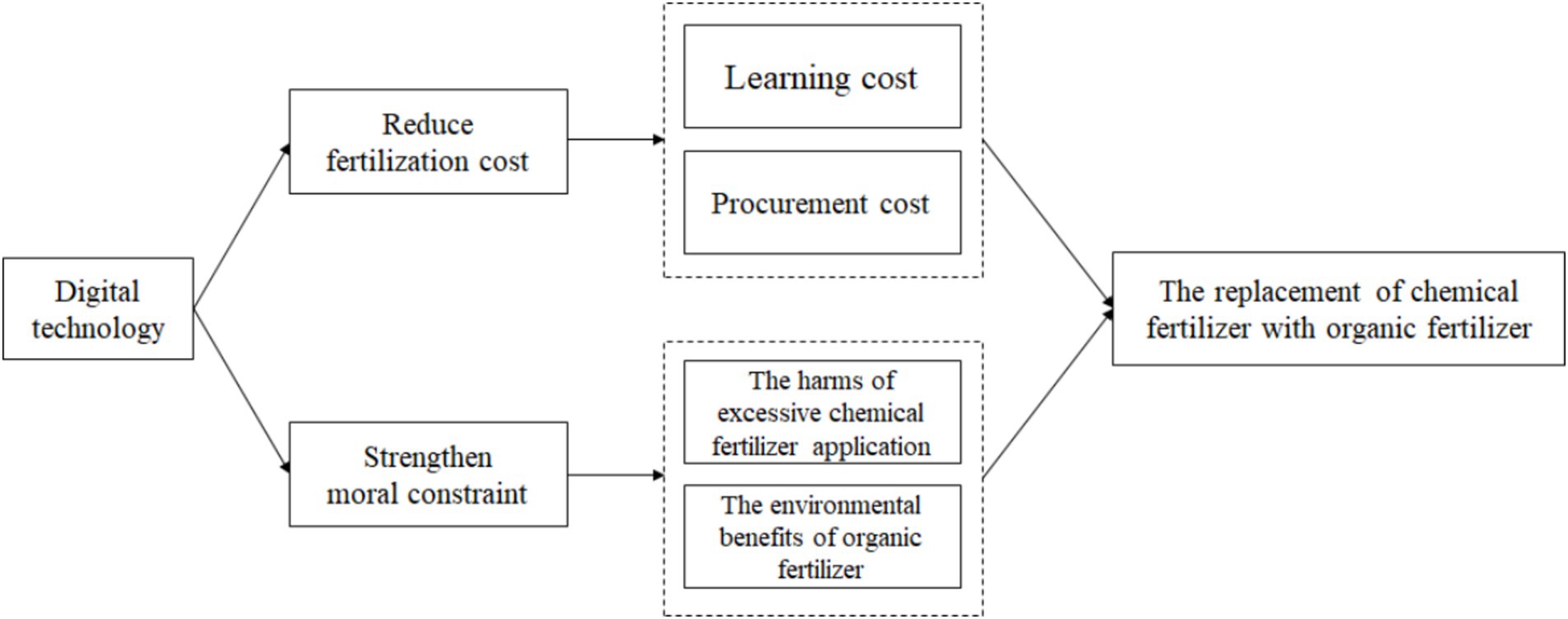
Figure 4. The analytical framework for digital technology promoting farmers’ application of organic fertilizer.
3.2 Ecological utility curves for farmers with different income levels
As an environment-friendly fertilizer, organic fertilizer has significant advantages in improving the quality of cultivated land and enhancing environmental benefits (Lee, 2010). Excessive application of chemical fertilizer can lead to agricultural non-point source pollution, thereby affecting farmers’ pursuit of environmental quality. This paper introduces the concept of “ecological utility” (Liu et al., 2024), meaning that as the application of chemical fertilizer increases, the perceived ecological utility by farmers gradually decreases. Given the differences in income levels among farmers in China, the ecological utility curves for farmers with different income levels vary.
High-income farmers typically have higher demands for environmental quality, use more advanced agricultural production techniques, and apply fertilizer in a relatively scientific and reasonable manner. These individuals assign a higher utility value to environmental quality, and their utility perception is more elastic with respect to environmental quality. In the initial stage, due to advanced environmental protection measures and scientific fertilization strategies, the impact of chemical fertilizer application on overall environmental quality is relatively small, resulting in a slow decline in the ecological utility curve. However, as the amount of chemical fertilizer applied increases, environmental quality rapidly deteriorates. Individuals become more sensitive to environmental degradation, and the ecological utility begins to decline at an accelerated rate. Ecological utility ( ) is a function of the chemical fertilizer application ( ). The ecological utility curve for high-income farmers, , is shown in Figure 5a.
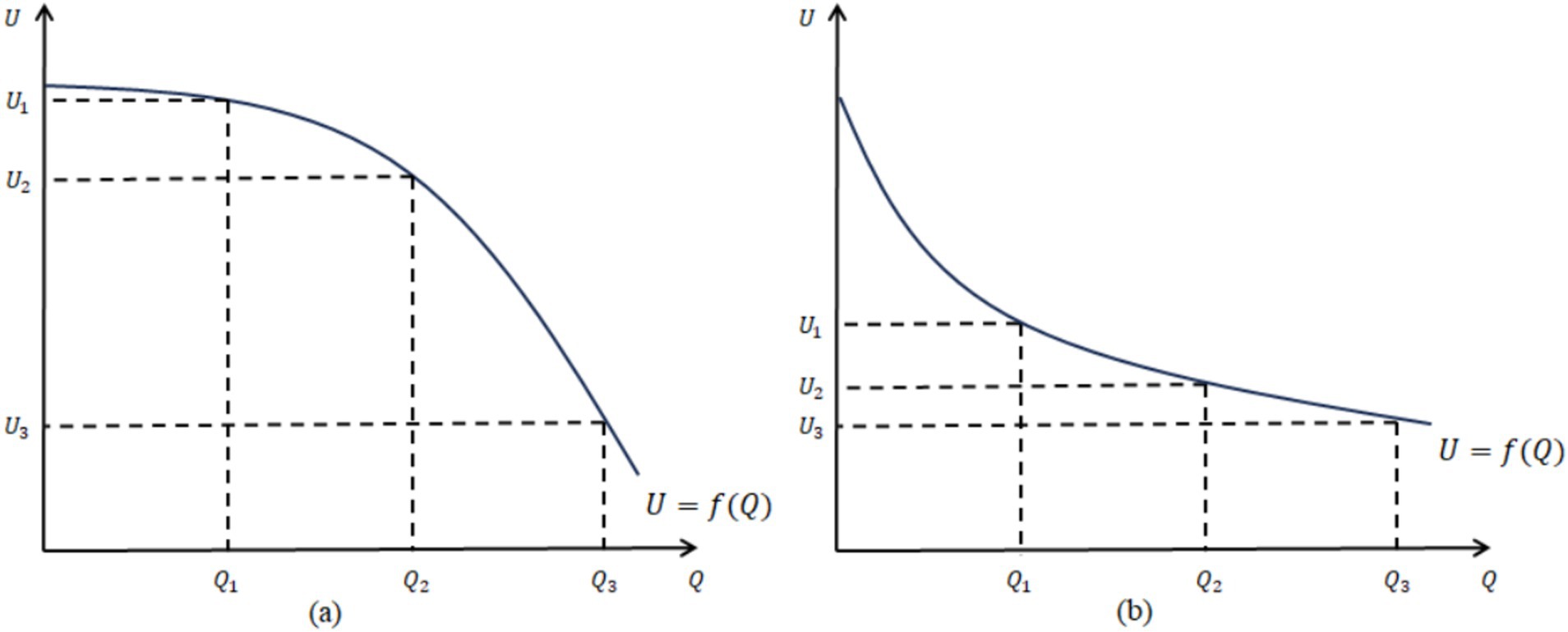
Figure 5. (a,b) represent ecological utility curve for high-income farmers and low-income farmers, respectively.
Low-income farmers invest less in environmental protection, apply fertilizer in a more extensive manner, and lack scientific guidance. Their expectations for environmental quality are lower, and their utility perception is less elastic with respect to environmental quality. In the initial stage, due to the lack of scientific management in fertilizer application, its impact on environmental quality is significant. Additionally, the absence of environmental regulation measures can lead to the “broken window effect,” which further exacerbates environmental degradation, causing a rapid decline in ecological utility. As the chemical fertilizer application increases, environmental quality continues to decline. However, due to the lower elasticity of individuals’ utility perception with respect to environmental quality, changes in ecological utility are relatively gradual. The ecological utility curve for low-income farmers is shown in Figure 5b.
As the chemical fertilizer application increases by equal amounts, the individual’s ecological utility decreases, represented by , , and , with . Based on the above analysis, for high-income farmers, ; for low-income farmers, .
4 Evolutionary game model
4.1 Symmetric game model of farmers without external intervention
4.1.1 Scenario description
During the fertilization process, farmers adjust their strategies based on the strategies of other farmers in the region, and this adjustment process is an evolutionary one. Specifically, farmers may choose organic fertilizer for agricultural production to pursue ecological utility and improve the quality of agricultural products, but the market value of green products is uncertain, and organic fertilizer requires higher costs. On the other hand, chemical fertilizers are less expensive and provide stable returns, but they are detrimental to environmental protection. After multiple rounds of games, farmers will choose the strategy that yields the highest returns based on their experience. This section first constructs a symmetric game model of farmers in the scenario without external intervention, analyzing the impact of imitation and learning mechanisms among farmers on strategy choices. The game framework is shown in Figure 6.
4.1.2 Model assumptions
Based on evolutionary game theory, in order to construct a scientific and reasonable game model and clearly elaborate on the stability of strategies and equilibrium points as well as the relationships between various factors, this paper proposes the following assumptions:
Assumption 1: One of the central principles of evolutionary game theory is that agents participate in repeated games under the assumption of bounded rationality until the game system evolves towards a stable state over time (Weibull, 1997). This model is a two-party symmetric game model with farmers as the main subjects, divided into Farmer A and Farmer B. It is assumed that information asymmetry exists during the game process, and all farmers have bounded rationality with differences in analysis and judgment abilities. Farmers’ strategy choices gradually adjust over time, and they improve their learning and imitation abilities during the game process, thereby making decisions that best align with the current environment and their own interests.
Assumption 2: For ease of analysis, we typically use binary strategies to analyze agents’ strategies (Xing et al., 2023; Sun et al., 2023). It is assumed that farmers have only two fertilization strategies: “organic fertilizer” and “chemical fertilizer.” Farmer A chooses “organic fertilizer” with a probability of and “chemical fertilizer” with a probability of . Farmer B chooses “organic fertilizer” with a probability of and “chemical fertilizer” with a probability of .
Assumption 3: Organic fertilizers must be produced using organic waste as raw materials, undergoing multiple rounds of fermentation and decomposition through biological transformation. During this process, strict control of temperature, humidity, oxygen supply, and microbial activity is required. In contrast, chemical fertilizers can be mass-produced directly through industrial synthesis at a relatively lower cost. Moreover, the trace elements in chemical fertilizers can be rapidly absorbed by crops, leading to a quick increase in yield. In contrast, organic fertilizers release nutrients gradually through microbial decomposition, resulting in a delayed effect on soil improvement and yield enhancement. This slow-release characteristic requires farmers to invest more time. Therefore, using organic fertilizers entails not only higher economic costs but also greater time and management costs. Let and represent the costs of using organic and chemical fertilizers, respectively, where > .
Assumption 4: Excessive use of chemical fertilizers leads to agricultural non-point source pollution, reducing farmers’ overall satisfaction with environmental quality. Given different amount of chemical fertilizer application , , farmers receive different ecological utility . As analyzed in Section 3.2, high-income farmers are more sensitive to environmental degradation. Therefore, the ecological utility of farmers with different income follows the relationship: . To quantify ecological utility and compare the benefits of different strategies, this study follows Liu’s approach by introducing the Monetary marginal utility and converting farmers’ ecological utility using . Since high-income farmers have stronger consumption capacity and lower sensitivity to income changes, their marginal utility is lower than that of low-income farmers, i.e., .
4.1.3 Payoff matrix
Based on the above assumptions, the payoff matrix for the symmetric game model of farmers without external intervention can be obtained, as shown in Table 2.
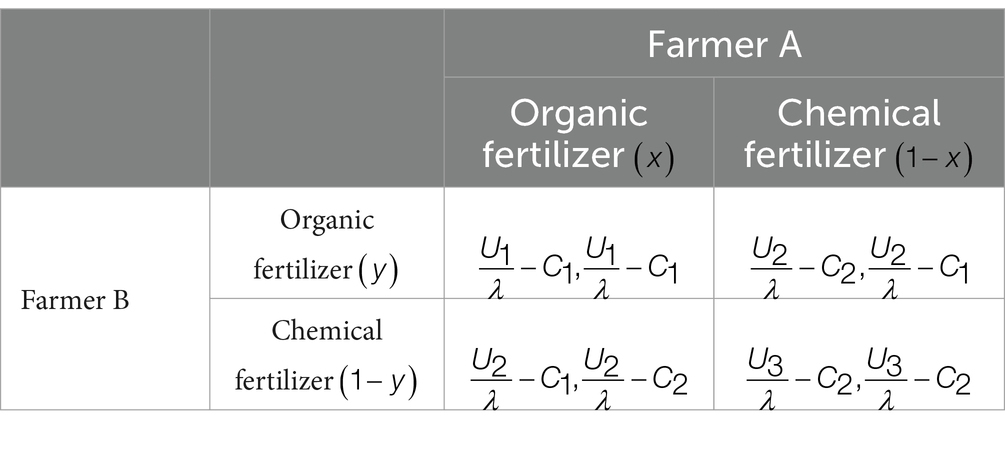
Table 2. Payoff matrix for the symmetric game model of farmers in the scenario without external intervention.
4.1.4 Expected payoff and replicator dynamics equation
According to evolutionary game theory and the constructed payoff matrix, the payoff functions and replicator dynamics equations for Farmer A and Farmer B under different decisions can be calculated as follows:
Let the expected payoffs for Farmer A when choosing “organic fertilizer” and “chemical fertilizer” be and , respectively, with the average expected payoff being , expressed by Equations 1–3, respectively. Then:
Since this model is a symmetric game model, the expected payoffs for Farmer B can be derived analogously, expressed by Equations 4–6:
Based on the expected payoffs, the replicator dynamics equations for Farmer A and Farmer B can be derived, expressed by Equations 7,8:
4.1.5 Data source
The data source and parameter calibration in this paper are primarily based on the following principles:
1. Field research on farmers in Zhejiang Province. Our research team conducted field surveys in multiple regions, including Wenzhou, Taizhou, and Jiaxing, where we gathered detailed information on key factors affecting agricultural production costs, such as agricultural input usage, cropping structures, and fertilization practices. Based on these findings, combined with publicly available data from agricultural input platforms, we estimated the application costs of different fertilizers, determining that the cost of organic fertilizer is 3, while the cost of chemical fertilizer is 1.
2. Policy reports and other public documents. We systematically reviewed relevant policy documents on organic and chemical fertilizers. Generally, subsidies for organic fertilizers account for approximately 30% of the purchase price, so the government subsidy is set at 1.
3. Existing literature and expert opinions. On the one hand, considering the consumption characteristics of farmers with different income, we referred to Liu’s approach in assigning values to the monetary marginal utility—setting it at 1 for low-income farmers and 0.8 for high-income farmers. On the other hand, for data that are difficult to obtain, such as ecological utility and farmers’ negative utility, we consulted 10 senior experts in the field of environmental science from universities, research institutions, and government departments. The relevant parameters were determined by summarizing expert opinions and calculating the average value to ensure the scientific validity and reliability of the research data.
The specific parameter settings are shown in Table 3.
The simulation analysis process in this study is as follows:
First, we substitute the parameters into the replicator dynamic equations and conduct an initial simulation using MATLAB (Scenario 1: Symmetric game model of farmers without external intervention). Next, we analyze the sensitivity of key parameters such as government subsidies and government promotion. Specifically, we use the variable values of low-income farmers in Scenario 1 as the baseline and adjust key parameter values accordingly to examine the mechanisms of government intervention (Scenario 2: Symmetric game model of farmers under government incentives). Finally, we conduct a sensitivity analysis to explore the impact of digital technology on farmers’ strategies, aiming to provide a more comprehensive perspective on promoting the replacement of organic fertilizers for chemical fertilizers (Scenario 3: Symmetric game model of farmers under the embedding of digital technology).
4.1.6 Preliminary evolutionary results
This section uses Matlab software to preliminarily simulate the evolution of the game system. To ensure the scientific accuracy and reliability of the results, the initial values of the parameters were adjusted and set based on field survey results and relevant research. The specific values are as follows: Figures 7a,b represent the evolutionary trends of fertilization strategies for high-income and low-income farmers, respectively, under different initial willingness. Generally speaking, in the absence of external intervention, the learning and imitation behavior among farmers are important factors influencing organic fertilizer application. When some farmers adopt organic fertilizer and achieve good results, other farmers are likely to imitate their practices, and this influence shows differentiated effects at different income levels.

Figure 7. (a,b) represent evolutionary result for high-income farmers and low-income farmers, respectively.
According to Figure 7a, regardless of the initial willingness, high-income farmers will eventually choose organic fertilizer for agricultural production. As the initial willingness increases, the speed of the system evolving to a steady state accelerates. This indicates that through mutual learning and imitation, high-income farmers are better able to achieve the replacement of chemical fertilizer with organic fertilizer. On the one hand, farmers’ income levels determine their willingness to engage in green production and their input of factors at each stage (Hayati et al., 2009). High-income farmers have a stronger risk-bearing capacity and sufficient ability to purchase organic fertilizers. On the other hand, according to Maslow’s hierarchy of needs theory, farmers with higher income levels, once their basic material needs are met, will pursue higher-level ecological utility (Janker et al., 2019). Moreover, in high-income areas, new agricultural operating entities such as family farms and farmers’ cooperatives possess abundant human and social resources, making them likely pioneers in the application of organic fertilizer. Relying on their own influence, they can play a demonstrative role, guiding and motivating surrounding small farmers to learn and imitate, thereby enhancing their willingness to apply organic fertilizer (Hoang et al., 2006).
According to Figure 7b, although an increase in initial willingness helps to slow down the evolution of low-income farmers’ strategies towards zero, low-income farmers will ultimately choose to apply chemical fertilizer. The main reasons are that low-income farmers have a high degree of risk aversion and weak environmental awareness, leading them to prefer “quick and easy” agricultural techniques for short-term gains (Wang et al., 2018). They lack the economic foundation to achieve the replacement of chemical fertilizer with organic fertilizer through learning and imitation. Overall, high-income farmers are better able to adopt organic fertilizer, while chemical fertilizer are the common choice for low-income farmers. To increase the willingness of low-income farmers to apply organic fertilizer, it is necessary for the government to take intervention measures.
4.2 Symmetric game model of farmers under government incentives
4.2.1 Model construction
The main reasons for low-income farmers’ low willingness to apply organic fertilizer are the lack of purchasing ability and environmental awareness. Government incentives are effective measures to improve this situation (Lv et al., 2023). The government primarily increases low-income farmers’ willingness to apply organic fertilizer through financial subsidies and government promotion. Excessive application of chemical fertilizers not only negatively impacts farmers’ own production but also affects the surrounding ecosystem, leading to public scrutiny and regulatory pressure. Therefore, the government strengthens education and promotion of green technologies and ecological protection to raise farmers’ environmental awareness and guide them toward moral constraints through policy measures. When environmental damage occurs due to excessive chemical fertilizer use, farmers experience negative utility due to guilt, representing their psychological loss from environmental harm. This is expressed as . Additionally, given that organic fertilizers are generally more expensive than chemical fertilizers and may lead to short-term income losses, the government provides financial subsidies amounting to to alleviate farmers’ economic burden.
The symmetric game framework of farmers under government incentives is shown in Figure 8, and the payoff matrix is shown in Table 4.
Since this model is a symmetric game model, the payoff situations of Farmer A and Farmer B are similar. Therefore, in this section and the subsequent game analysis, Farmer A is taken as an example, and the strategy evolution of Farmer B can be derived analogously. The expected payoffs for Farmer A were expressed by Equations 9–11, respectively.
Based on the expected payoffs, the replicator dynamics equation for Farmer A can be derived as Equation 12:
Take the partial derivative with respect to x, as shown in Equation 13:
Let:
According to the stability conditions of the replicator dynamics equation, when and are satisfied, this point is the evolutionary stable point for Farmer A. According to Equation 14, when y = y*=, G(y)=0, and for any value of x, F(x) ≡ 0. When , , and for any value of , . Under this condition, the strategy choice of Farmer A does not change over time, and the stable strategy is any strategy. When , setting yields two possible equilibrium solutions: and . (1) When and , , and , then is the evolutionary stable strategy for Farmer A. (2) When , , and , then is the evolutionary stable strategy for Farmer A. Based on the above analysis, when , farmers will choose to apply organic fertilizer. Next, this paper will further discuss the impact of government incentives on farmers’ willingness to apply organic fertilizer.
, and since , decreases as increases, meaning that when rises, , and the stable point converges towards . Therefore, the following corollary is made:
Corollary 1: Financial subsidies positively influence farmers’ willingness to apply organic fertilizer.
, and since , decreases as increases, meaning that when rises, , and the stable point converges towards . Therefore, the following corollary is made:
Corollary 2: Government promotion helps to strengthen moral constraints, positively influencing farmers’ willingness to apply organic fertilizer.
4.2.2 Stability analysis
Under conditions of information asymmetry, the evolutionary stable strategy is necessarily a pure strategy (Selten and Selten, 1988). Setting yields four pure strategy equilibrium points: . According to Lyapunov stability theory, the eigenvalues of the Jacobian matrix can be used as a criterion for determining the evolutionary stability of local equilibrium points. A local equilibrium point satisfies the condition of asymptotic stability if and only if all eigenvalues are negative. Therefore, the Jacobian matrix is constructed based on the replicator dynamics equations, and its eigenvalues are calculated to determine whether the local equilibrium points are stable (see Table 5).
represents the ideal evolutionary stable point of this model, where all farmers choose organic fertilizer. According to the Lyapunov indirect method, if all the eigenvalues of an equilibrium point have negative real parts, then that equilibrium point is an evolutionary stable point. To achieve this ideal state, the eigenvalues of must all be less than 0. Therefore, the following constraint condition is derived: when , meaning that the net income from applying organic fertilizer is higher than the net income from applying chemical fertilizer, is the evolutionary stable point of the game system.
4.2.3 Evaluation indicators
This paper measures the diffusion rate of organic fertilizer (see Equation 15) by calculating the average time required for organic fertilizer to spread to all farmers, and the effectiveness of the policy (see Equation 16) is assessed by the proportion of time saved in the diffusion of organic fertilizer (He and Liao, 2024). This paper measures the diffusion rate of organic fertilizer by calculating the average time required for organic fertilizer to spread to all farmers, and the effectiveness of the policy is assessed by the proportion of time saved in the diffusion of organic fertilizer (He and Liao, 2024). The specific calculation formulas are as follows:
Where represents the willingness to apply organic fertilizer at time , represents the time when , is the average time required for organic fertilizer to spread to all farmers, and is the proportion of time saved in the diffusion of organic fertilizer.
4.2.4 Sensitivity analysis
Based on corollary 1 and corollary 2, combined with the theoretical analysis framework of this paper, the key factors influencing farmers’ willingness to apply organic fertilizer include financial subsidies and government promotion. Therefore, this section will discuss the sensitivity of above parameters within constraint conditions. Let , representing the low initial willingness of low-income farmers to apply organic fertilizer, which also aligns with the current state of organic fertilizer replacing chemical fertilizer in China (Wang et al., 2018). When simulating the sensitivity of parameters, other parameters are kept constant. The parameters in this paper are mainly obtained through three channels: firstly, based on the relevant subsidy policies issued by the Chinese government; secondly, through our field research with farmers in Jiaxing, Wenzhou, and Taizhou in Zhejiang Province, where first-hand data were collected from interviews; thirdly, in consultation with experts in the field of agriculture. Based on the information obtained from the above three channels, this paper has simplified the data processing, with the specific parameter settings as follows: .
4.2.4.1 The impact of financial subsidies on farmers’ fertilization strategies
Government subsidies can effectively reduce the purchase cost of organic fertilizer, alleviating the economic pressure on low-income farmers in terms of input costs, and play a crucial role in promoting organic fertilizer application (Wang et al., 2018). This section scales the financial subsidy parameter by based on the baseline value , setting , and to explore the net effect of financial subsidies on farmers’ willingness to apply organic fertilizer. The simulation results are shown in Figure 9. According to the simulation results, government subsidies have a significant positive impact on applying organic fertilizer. When , government subsidies are insufficient to cover the high costs of organic fertilizer, leading farmers to prefer chemical fertilizer. When , as the subsidy amount increases, farmers’ willingness significantly improves and eventually stabilizes at “ .” Organic fertilizer requires higher production costs and is an emerging technology with uncertain expected returns. When financial subsidies are low, rational farmers tend to apply chemical fertilizer to achieve more stable returns (Bocquého et al., 2014). As the subsidy amount increases, government subsidies boost farmers’ current disposable income, significantly increasing their willingness to apply organic fertilizer in the short term. However, compared to the baseline scenario, in the absence of moral constraints, promoting the application of organic fertilizer requires larger subsidies, which increases the financial burden on the government and is not conducive to the efficient allocation of resources (He et al., 2023).
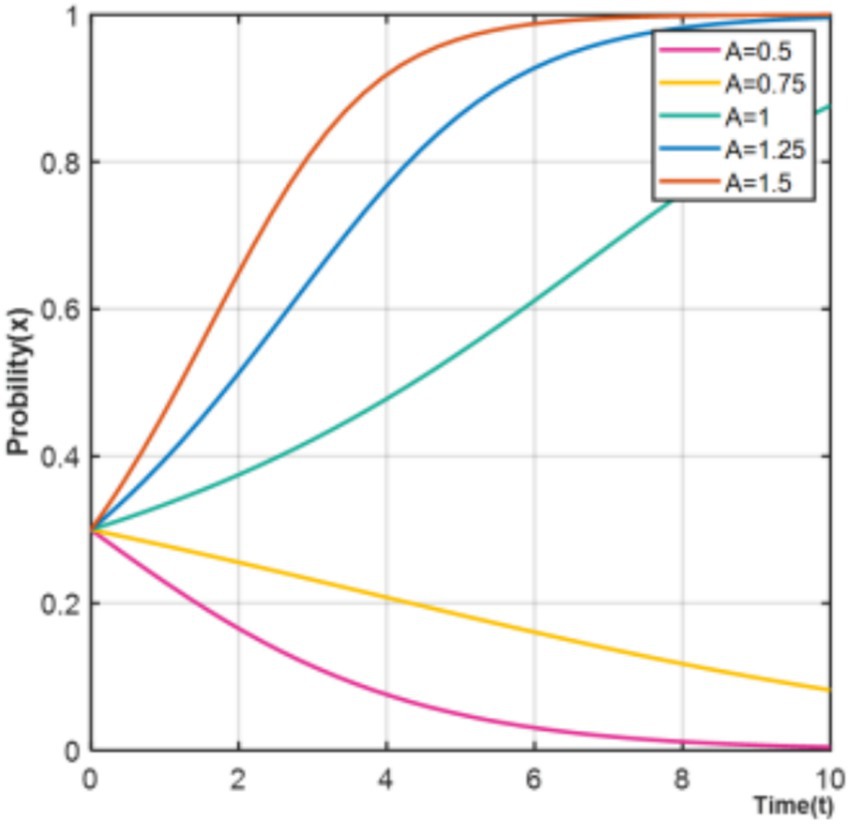
Figure 9. The impact of financial subsidies on farmers’ willingness to apply organic fertilizer when .
4.2.4.2 The impact of government promotion on farmers’ fertilization strategies
Government promotion can eliminate farmers’ doubts about organic fertilizer, enhance their awareness of its economic and environmental benefits, and stimulate their sense of social responsibility. In this paper, the range of negative utility ( ) generated by moral constraints is set as , and is assigned values with a step size of within this range, i.e., . The government subsidy is set to to analyze the net effect of government promotion. The simulation results are shown in Figure 10a. According to the simulation results, increasing moral constraints has a certain positive effect on promoting farmers to apply chemical fertilizer. However, when , relying solely on moral constraints is not sufficient to achieve the replacement of chemical fertilizer with organic fertilizer. When , farmers’ strategies begin to evolve towards “ ,” but they do not reach a stable state within the simulation period. To this end, we further doubled the simulation period, setting . The simulation results are shown in Figure 10b. According to the simulation results, when , the farmers’ final strategy stabilizes at “ ,” indicating that relying on government promotion to achieve a stable system state requires a longer time. Theoretically, relying solely on government promotion to strengthen moral constraints could achieve the replacement of chemical fertilizer with organic fertilizer. However, in reality, the establishment and cultivation of ecological morality is a time-consuming process, and it is difficult to achieve moral constraints at a level of (Eekelaar, 2012). Additionally, farmers’ strategy is primarily based on the costs and benefits of their current decisions rather than purely moral factors, which limits the effectiveness of government promotion.
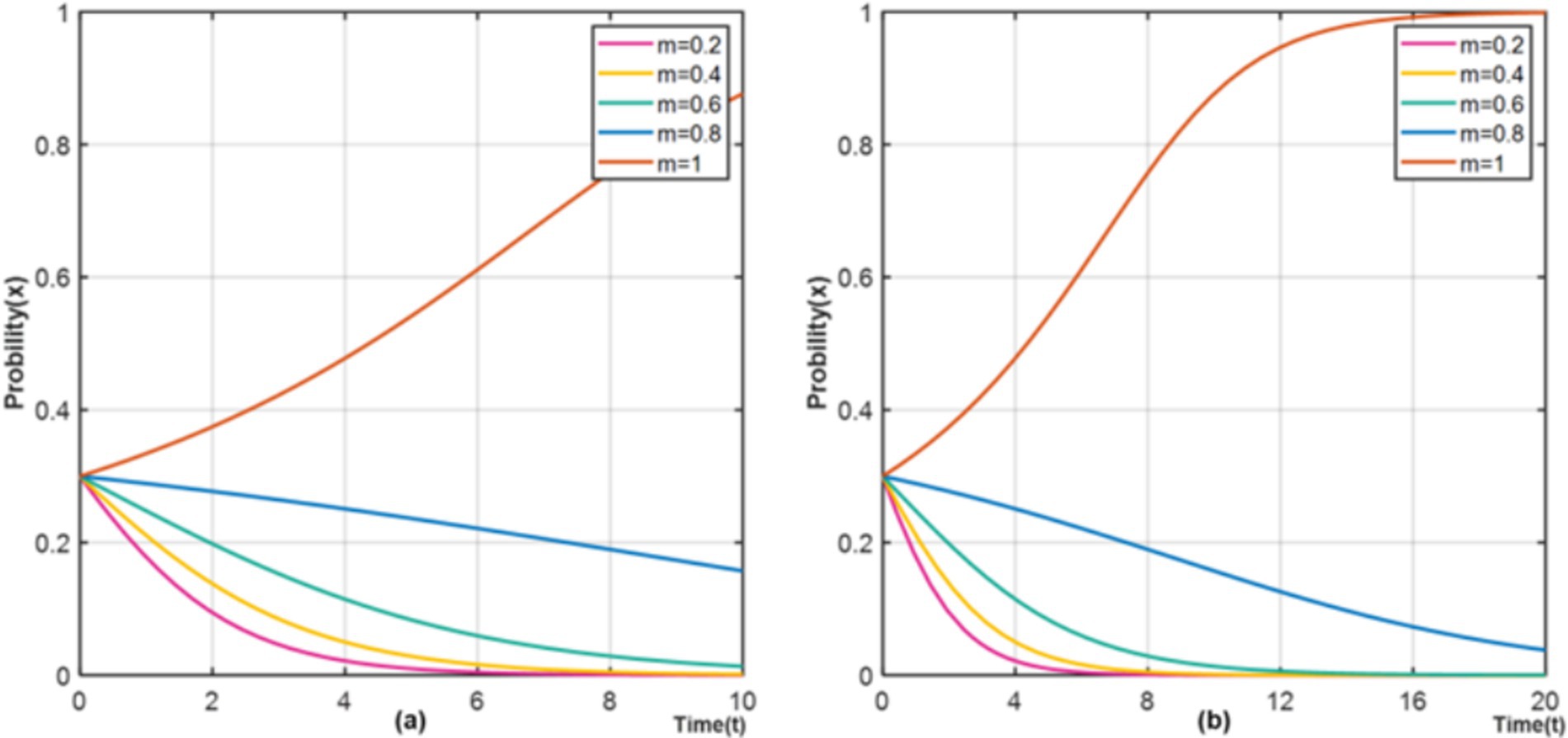
Figure 10. (a) Represents the impact of government promotion on farmers’ fertilization strategies under the scenario where the subsidy is zero. (b) Shows the evolutionary results after extending the simulation period.
4.2.4.3 The combined impact of financial subsidies and government promotion on farmers’ fertilization strategies
The “Porter Effect” suggests that reasonable environmental regulation policies can promote technology application. The first-mover advantage created by this can offset the costs of environmental governance, achieving a win-win situation for both economic development and environmental protection. Although government subsidies can achieve significant incentive effects in the short term, they will increase the financial burden of the government. Moral constraints often take a long time to manifest, and the effect is limited. In practice, the government often adopt both financial subsidies and government promotion to intervene in farmers’ fertilization strategies. Based on this, this paper sets to represent low, medium, and high levels of moral constraints, respectively. At the same time, the subsidy parameter is adjusted within the range, i.e., , to comprehensively analyze the effects of the policy combination. The simulation results are shown in Figure 11. According to the simulation results, as moral constraints increase, financial subsidies at the same level have a stronger incentive effect. Strengthening government promotion can enhance farmers’ intrinsic motivation to apply organic fertilizer, reduce their dependence on financial subsidies. Financial subsidies can directly change the cost–benefit situation of farmers, achieving more immediate incentive effects in the short term, effectively compensating for the slow impact of government promotion. To more intuitively demonstrate the policy efficiency, this section calculates the proportion of time saved in the diffusion of organic fertilizer based on the formulas from Section 4.2.3, as shown in Table 6.

Figure 11. (a, b, c) represent the impact of government subsidies on farmers’ fertilization strategies when government promotion is 0.2, 0.4, and 0.6, respectively.
There have already been successful cases in promoting the replacement of chemical fertilizer with organic fertilizer through a combination of government incentive policies. Anji Songming White Tea Co., Ltd. is a leading white tea enterprise in Anji County and has been actively exploring the replacement of chemical fertilizer with organic fertilizer in recent years. To support this initiative, the Anji government has actively introduced an implementation plan for promoting organic fertilizer application and conducted training on the technology for replacing chemical fertilizer with organic fertilizer. Financial subsidies have also been provided. For example, Songming White Tea Co., Ltd.’s 600 mu organic tea garden received subsidies of 600 yuan, 420 yuan, and 300 yuan per mu in 2017, 2018, and 2019, respectively. With government promotion and financial support, Anji Songming White Tea Co., Ltd. has become a key demonstration unit for the replacement of chemical fertilizer with organic fertilizer in Anji, and has influenced surrounding agricultural entities to apply organic fertilizer.
4.3 Symmetric game model of farmers under the embedding of digital technology
4.3.1 Model construction
The development of digital technology provides new opportunities to accelerate the replacement of chemical fertilizer with organic fertilizer. Based on this, this section sets a digital level to measure the impact of digital technology on farmers’ willingness to apply organic fertilizer. Specifically, digital technology can reduce the adoption cost of organic fertilizer. When farmers apply organic fertilizer, the cost is reduced to . At the same time, the government can use digital platforms to conduct promotion and education more efficiently, thereby strengthening farmers’ moral constraints. As a result, the negative utility increases to . The game framework after the embedding of digital technology is shown in Figure 12. Combining Table 2, we can derive the farmers’ payoff matrix after the embedding of digital technology, as shown in Table 7.
The payoff function for Farmer A after the embedding of digital technology can be expressed as Equations 17–19:
The replicator dynamics equation can be expressed as Equation 20:
Take the partial derivative with respect to x, as shown in Equation 21:
Let:
According to the stability conditions of the replicator dynamics equation, when and are satisfied, this point is the evolutionary stable point for Farmer A. , , According to Equation 22, when y = y*=, G(y)=0, and for any value of x, F(x) ≡ 0. Under this condition, the strategy choice of Farmer A does not change over time, and the stable strategy is any strategy. When , setting yields two possible equilibrium solutions: and . (1) When and , , and , then is the evolutionary stable strategy for Farmer A. (2) When , , and , then is the evolutionary stable strategy for Farmer A. Based on the above analysis, when , farmers will choose to replace chemical fertilizer with organic fertilizer.
, and since , decreases as increases, meaning that when rises, , and the stable point converges towards . Therefore, the following corollary is made:
Corollary 3: Digital technology positively influences farmers’ willingness to apply organic fertilizer.
4.3.2 Sensitivity analysis
Long-term subsidies can easily lead to opportunistic behavior and increase the financial burden. The ideal scenario for subsidies is to gradually reduce the amount until it is phased out of the market (Hao et al., 2022). When the government provides subsidies, the cost of organic fertilizer for farmers decreases from to . With the embedding of digital technology, the negative utility caused by moral constraints for farmers increases from to , and the cost of organic fertilizer decreases from to . Subsidy policies and digital technology alter the cost–benefit situation through different mechanisms. When government subsidies are zero, can the dividends released by digital technology achieve the replacement of chemical fertilizer with organic fertilizer? To answer this question, this section sets the subsidy parameter to and adjusts the digital level on this basis. Since the main participants of the game are low-income farmers, with a lower level of digital development, the baseline value for the digital level is set at . The digital level ranges from , and this section gradually increases the digital level with a step size of , that is, setting . The simulation results are shown in Figure 13. According to the simulation results, the digital level positively influences farmers’ willingness to apply organic fertilizer. When , the moral constraints and cost reduction effects brought by digital technology are limited. In the absence of financial subsidies, applying organic fertilizer requires higher costs, leading farmers to prefer chemical fertilizer. As the digital level increases, farmers’ willingness to adopt organic fertilizer significantly improves, and the speed at which it evolves to a steady state accelerates. When , farmers’ willingness to apply organic fertilizer stabilizes at 1. This indicates that digital technology can effectively enhance farmers’ willingness to apply organic fertilizer, producing effects similar to those of financial policies.
5 Further discussion
Whether farmers choose to apply organic fertilizer is a rational decision made after weighing costs and benefits. If the net benefits after adoption are higher than before, farmers tend to choose organic fertilizer. The increase in net income is partly due to the rise in market returns. In recent years, as consumer income has increased, environmental awareness has grown, and concerns about food safety have intensified, the demand for green agricultural products in China has significantly increased (Wang and Wang, 2010; Jin et al., 2020). Compared to chemical fertilizer, organic fertilizer can significantly improve the quality of agricultural products (Midingoyi et al., 2019). When demand orientation and structure change, it incentivizes farmers to adopt new production technologies to meet market demand (Schmookler, 1966). Specifically, if the market is efficient, the improvement in product quality due to organic fertilizer will lead to price increases through the price mechanism, thereby increasing farmers’ income. Therefore, the key to encouraging farmers to apply organic fertilizer lies in the market value of green agricultural products being recognized (Waithaka et al., 2007; Huang et al., 2018). However, the development of the green agricultural product market in China is still not fully mature and relies on government guidance to establish a standardized market system. Therefore, the government needs to improve the unified standards for quality testing and certification of green agricultural products to reflect the market principle of “high quality, high price.” At the same time, on the consumer side, the government should strengthen the promotion to guide consumer preferences towards green and organic agricultural products, driving a transformation in production methods and achieving the replacement of chemical fertilizer with organic fertilizer (Goetzke et al., 2014).
The increase in net income also comes from the reduction of production costs. Farmers applying organic fertilizer need to bear additional technology adoption costs, including input costs, risk costs, and learning costs, among others. Currently, China’s market mechanism for green agricultural products is still underdeveloped, leading to uncertainty in the economic returns of these products. Combined with the high costs, farmers lack sufficient motivation to choose organic fertilizer (Yu and Zhang, 2009). Financial subsidies, as a non-market-oriented and inclusive incentive method, can directly increase farmers’ disposable income and reduce technology adoption costs, thereby encouraging farmers to apply organic fertilizer. This serves as an effective supplement when market guidance mechanisms are not fully developed. However, existing research shows that financial subsidies are effective only in the short term and can easily lead to the awkward situation of “using when subsidized, stopping when not.” This makes it difficult to fundamentally stimulate farmers’ willingness to apply organic fertilizer (Takeshima and Nkonya, 2014). The reason is that the target group for financial subsidies is large and dispersed, making the supervision and monitoring of organic fertilizer costly. This can easily lead to speculative behaviors such as “subsidy fraud,” and through farmers’ herd mentality and imitation, it can result in widespread opportunistic behavior (Zhang and Luo, 2022). Moreover, the financial burden brought by subsidies presents a practical challenge for the long-term sustainability of subsidy policies (Fan et al., 2023). Therefore, the government need to accelerate the development of the green agricultural product market, stimulating farmers’ willingness to adopt organic fertilizer by enhancing product value, thereby creating a self-enforcing mechanism compatible with financial subsidies. The development of digital technology provides a potential solution to improve the current situation.
The deep integration of digital technology with the agricultural materials procurement can enrich the forms of agricultural factor markets, reduce the level of information asymmetry between farmers and suppliers, and increase farmers’ options and comparisons of agricultural materials. This enables farmers to obtain higher-quality organic fertilizer at lower prices and with greater efficiency (Wang et al., 2023). In the production phase, providing technical training through platforms like short videos and agricultural apps can deepen farmers’ technical and ecological understanding, reducing the learning costs associated with organic fertilizer (Weng et al., 2023). At the same time, digital technologies such as agricultural IoT devices, big data, cloud computing, and 5G can enable digital information monitoring and sensing, precise quantitative decision-making, and intelligent precision operations and management throughout the entire agricultural production process, ensuring high yields and high quality of crops (Yi et al., 2021). In the field of agricultural product distribution, promoting the efficient circulation of green agricultural products is key to bridging the “last mile” from farmland to dining table. Accelerating the integration of digital technology with sales can help address the constraints of traditional agricultural product sales models, such as single consumer groups, poor information communication, and low efficiency despite high costs, thereby increasing the rate of transformation from agricultural commodity capital to monetary capital (Wang et al., 2023). Currently, the primary form of integrating digital technology with agricultural product sales is through e-commerce. E-commerce platforms break the limitations of physical space, expanding customer bases and market reach (Liu and Kao, 2022). At the same time, by collecting and analyzing data, farmers can improve their sensitivity to changes in demand, enabling them to adjust production decisions promptly, ensure effective coordination across all stages of agricultural production and operation, and reduce the risk of unsold products. In terms of agricultural product transportation, using digital methods such as temperature control systems and cold chain technology can effectively improve the logistics environment, thereby ensuring the economic value of agricultural products (Onwude et al., 2020).
From an international perspective, based on the findings of this study, the learning and imitation behavior of high-income farmers have played a positive role in promoting the application of organic fertilizer. By leveraging the demonstration effect of new agricultural operating entities such as family farms, agricultural cooperatives, and leading enterprises, it is possible to effectively encourage more farmers to apply organic fertilizer. This strategy can be promoted in economically developed countries. For example, in the Netherlands, agricultural cooperatives centralize the purchasing, production, and promotion of organic fertilizer, allowing farmers to obtain high-quality organic fertilizer at lower costs. On this basis, the cooperatives also actively organize technical training and experience exchange activities to help farmers master green production technologies. In contrast, it is difficult to achieve agricultural green transformation for low-income farmers by relying solely on self-learning and imitation. Financial subsidies and government promotion become effective incentives in this context, making this strategy suitable for developing countries with lower agricultural production levels. For example, in India, the government provides organic fertilizer production subsidies, especially for impoverished regions and smallholders, while also collaborating with agricultural technology departments to offer technical support for farmers. In Brazil, the government not only introduces financial subsidies and tax exemptions but also frequently organizes farmers’ conferences and field schools to provide technical training for farmers. Furthermore, the development of digital technologies offers great potential for promoting green agricultural production. As revealed in this paper, digital technologies can significantly enhance the efficiency of organic fertilizer promotion. In recent years, artificial intelligence, through technologies such as big data, machine learning, and the Internet of Things (IoT), has enabled precise analysis of various factors in agricultural production, including soil quality, climate change, and crop growth conditions, thereby providing farmers with scientific and personalized agricultural technical support (Kliestik et al., 2023; Dvorský et al., 2023). In the practice of promoting organic fertilizers through digital technology, the IoT technology in the United States can monitor soil health and crop growth in real-time and facilitate precise fertilization. In Germany, precision agriculture equipment helps farmers flexibly adjust fertilization plans based on land needs. In developing countries like Kenya and India, digital technologies are mainly used to build digital platforms to provide technical guidance.
6 Conclusions and policy implications
6.1 Conclusion
The replacement of chemical fertilizer with organic fertilizer is the optimal choice for alleviating resource and environmental pressures in China, enhancing grain productivity, ensuring food safety, and achieving green agricultural development (Chu et al., 2012). Based on the assumption of bounded rationality, this paper constructs symmetric game models of farmers under three scenarios: no external intervention, government incentives, and the embedding of digital technology. It differentially analyzes the fertilization decisions and evolutionary paths of farmers with different income levels. On this basis, the paper further discusses the impact of government incentives and digital technology on the willingness of low-income farmers to apply organic fertilizer. The main conclusions are as follows: First, income level has a differentiated impact on farmers’ herd behavior. High-income farmers can effectively adopt organic fertilizer through learning and imitation, while the application of chemical fertilizer remains a common choice for low-income farmers. Second, government subsidies can significantly increase the willingness to adopt organic fertilizer in the short term, but due to heavy financial burdens, it is difficult to sustain in the long run. Policy promotion can strengthen farmers’ moral constraints, but the effect of moral constraints is limited due to the long-term nature of ecological moral cultivation. Third, in the scenario where government subsidies are withdrawn, digital technology can significantly reduce the cost of technology adoption for farmers, while further strengthening their moral constraints, thereby promoting the application of organic fertilizer technology.
6.2 Policy implications
Based on the above conclusions and the current state of organic fertilizer replacing chemical fertilizer in China, this paper proposes the following policy recommendations.
Firstly, the government should integrate digital technology to promote organic fertilizer. On the one hand, the government should increase investment in construction to address shortcomings in digital infrastructure, accelerating the development of high-speed, smooth-running, and universally accessible communication networks that cover both urban and rural areas, thereby providing practical guarantees for the embedding of digital technology. On the other hand, the government should emphasize the primary role of farmers and strengthen educational and training efforts for them, guiding farmers to actively learn digital technology and improve their digital literacy, thereby providing human resources support for the embedding of digital technology. On this basis, digital platforms such as short videos, official accounts, and agricultural apps can be leveraged to promote content related to replacing chemical fertilizer with organic fertilizer, enabling farmers to access accurate and practical technical information in a timely manner and reducing the risks of improper technology application.
Secondly, the organic fertilizer subsidy policy should be improved by implementing differentiated standards for farmers with different income levels and providing subsidies based on their actual circumstances. Additionally, it is important to pay attention to farmers’ feedback on organic fertilizer subsidies and the quality of organic fertilizer, as well as their policy demands. The promotion of organic fertilizer subsidy policies should be strengthened, and the subsidy situation should be publicly disclosed in a timely manner to increase farmers’ awareness of the policies.
Finally, green agricultural development should rely not only on financial subsidies but also on the intrinsic behavioral constraints of farmers. Therefore, the government should increase investment in ecological education, enhancing farmers’ awareness of the environmental benefits of organic fertilizer and strengthening their intrinsic motivation to apply organic fertilizer. Additionally, farmers’ herd mentality and imitation behavior are important factors. New agricultural operating entities, such as family farms and specialized large-scale farms, have a more comprehensive understanding of green agricultural technologies like organic fertilizer. Using these entities as entry points for technology promotion can have a demonstrative effect on ordinary farmers, increasing their willingness to apply organic fertilizer and thereby promoting green agricultural development.
6.3 Limitations and future research directions
The theoretical significance of this paper lies in providing a comprehensive framework for understanding farmers’ application of organic fertilizer. It analyzes the differentiated effects of learning and imitation behaviors, incentive policies, and the effectiveness of digital technologies. In terms of practical implications, this paper offers policy recommendations for promoting the organic fertilizer application. However, there are certain limitations: First, the analysis is limited to the perspective of evolutionary game theory, neglecting other theoretical frameworks such as innovation systems, decision support systems, and institutional economics. Future research could consider integrating multiple theoretical frameworks, such as innovation systems and institutional economics, to gain a more comprehensive understanding. Second, this paper only considers the interests of farmers, while the promotion of organic fertilizer often involves more stakeholders, such as fertilizer distributors. Additionally, this paper performs a sensitivity analysis under the premise of government intervention, but whether the government has sufficient motivation to intervene depends on the cost–benefit situation after intervention. There exists a certain level of game theory between the government and farmers. Furthermore, the market value of agricultural products is also an important factor in incentivizing farmers to adopt organic fertilizers. Future research can further incorporate other stakeholders, such as the government and fertilizer distributors, and consider market-related variables such as price and sales volume, and their impact on system evolution. Third, the analysis of the evolutionary game model requires high-quality and representative data to predict the behavior of stakeholders. Although the data in this paper come from survey cases and policy documents, the methods of data collection and some of the values still exhibit a certain degree of subjectivity. Moreover, in reality, stakeholders’ decisions are often influenced by factors such as incomplete information, cognitive limitations, and emotions, making it difficult for the evolutionary game model to fully analyze all these factors. Therefore, future research could further improve the model by incorporating additional factors for empirical testing.
Data availability statement
The original contributions presented in the study are included in the article/supplementary material, further inquiries can be directed to the corresponding author.
Author contributions
FL: Methodology, Writing – original draft, Writing – review & editing. YZ: Conceptualization, Funding acquisition, Writing – review & editing. XW: Supervision, Writing – review & editing.
Funding
The author(s) declare that financial support was received for the research and/or publication of this article. This research was funded by National Social Science Fund (22BGL112), Wenzhou Science and Technology Specialist Program (X2023093) and Vegetable Farmers’ Behavior Logic and Policy Compensatory Mechanism for Replacing Chemical Fertilizers by Organic Fertilizers (72103081).
Conflict of interest
The authors declare that the research was conducted in the absence of any commercial or financial relationships that could be construed as a potential conflict of interest.
Generative AI statement
The authors declare that no Gen AI was used in the creation of this manuscript.
Publisher’s note
All claims expressed in this article are solely those of the authors and do not necessarily represent those of their affiliated organizations, or those of the publisher, the editors and the reviewers. Any product that may be evaluated in this article, or claim that may be made by its manufacturer, is not guaranteed or endorsed by the publisher.
Footnotes
1. ^Data source: China Statistical Yearbook 2023.
2. ^In fact, as early as 1988 and 1991, the Chinese government had already issued the “Notice on Paying Attention to and Strengthening Organic Fertilizer Work” and the “Notice on Further Strengthening Organic Fertilizer Work,” respectively.
3. ^Ministry of Finance: Central government support for soil testing and formulated fertilization achieves significant results (http://www.gov.cn/xinwen/2014-04/16/content_2660833.htm).
4. ^In April 2017, the Ministry of Agriculture launched the Five Major Actions for Agricultural Green Development, which included the action of replacing chemical fertilizer with organic fertilizer in fruits, vegetables, and tea.
5. ^In Jinshan District, Shanghai, subsidies of 200 yuan per ton are provided to farmers who use commercial organic fertilizers. In Haining, Zhejiang Province, financial subsidies are implemented for the promotion and application of commercial organic fertilizers, with a subsidy standard of 300 yuan per ton. In Beijing, a subsidy of 480 yuan per ton is provided for up to 1 ton of commercial organic fertilizer per mu of land.
References
Akbari, M., Loganathan, N., Tavakolian, H., Mardani, A., and Štreimikienė, D. (2021). The dynamic effect of Micro-structural shocks on private investment behavior. Acta Montan. Slovaca. 26, 1–17. doi: 10.46544/AMS.v26i1.01
Aker, J. C. (2011). Dial “a” for agriculture: a review of information and communication technologies for agricultural extension in developing countries. Agric. Econ. 42, 631–647. doi: 10.1111/j.1574-0862.2011.00545.x
Bocquého, G., Jacquet, F., and Reynaud, A. (2014). Expected utility or prospect theory maximisers? Assessing farmers' risk behaviour from field-experiment data. Eur. Rev. Agric. Econ. 41, 135–172. doi: 10.1093/erae/jbt006
Chen, Y., Fu, X., and Liu, Y. (2022). Effect of farmland scale on farmers’ application behavior with organic fertilizer. Int. J. Environ. Res. Public Health 19:4967. doi: 10.3390/ijerph19094967
Chen, X., Zeng, D., Xu, Y., and Fan, X. (2018). Perceptions, risk attitude and organic fertilizer investment: evidence from rice and banana farmers in Guangxi, China. Sustain. For. 10:3715. doi: 10.3390/su10103715
Chu, C., Feng, S., and Zhang, W. (2012). An empirical analysis of Farmers’ adoption of environmentally friendly agricultural technologies: a case study of organic fertilizer and soil testing and fertilizer recommendation technology. Chin. Rural Econ. 3, 68–77.
Coninx, K., Deconinck, G., and Holvoet, T. (2018). Who gets my flex? An evolutionary game theory analysis of flexibility market dynamics. Appl. Energy 218, 104–113. doi: 10.1016/j.apenergy.2018.02.098
Du, X., Wang, X., and Hatzenbuehler, P. (2023). Digital technology in agriculture: a review of issues, applications and methodologies. China Agric. Econ. Rev. 15, 95–108. doi: 10.1108/CAER-01-2022-0009
Dvorský, J., Bednarz, J., and Blajer-Gołębiewska, A. (2023). The impact of corporate reputation and social media engagement on the sustainability of SMEs: perceptions of top managers and the owners. Equilibrium 18, 779–811. doi: 10.24136/eq.2023.025
Eekelaar, J. (2012). Self-restraint: social norms, individualism and the family. Theor. Inq. Law 13, 75–95. doi: 10.1515/1565-3404.1285
Falconer, K., and Hodge, I. (2001). Pesticide taxation and multi-objective policy-making: farm modelling to evaluate profit/environment trade-offs. Ecol. Econ. 36, 263–279. doi: 10.1016/S0921-8009(00)00236-6
Fan, P., Mishra, A. K., Feng, S., and Su, M. (2023). The effect of agricultural subsidies on chemical fertilizer use: evidence from a new policy in China. J. Environ. Manag. 344:118423. doi: 10.1016/j.jenvman.2023.118423
Fang, P., Abler, D., Lin, G., Sher, A., and Quan, Q. (2021). Substituting organic fertilizer for chemical fertilizer: evidence from apple growers in China. Land 10:858. doi: 10.3390/land10080858
Friedman, D. (1991). Evolutionary games in economics. Econometrica 59, 637–666. doi: 10.2307/2938222
Goetzke, B., Nitzko, S., and Spiller, A. (2014). Consumption of organic and functional food. A matter of well-being and health? Appetite 77, 96–105. doi: 10.1016/j.appet.2014.02.012
Guo, Y., and Wang, J. (2021). Spatiotemporal changes of chemical fertilizer application and its environmental risks in China from 2000 to 2019. Int. J. Environ. Res. Public Health 18:11911. doi: 10.3390/ijerph182211911
Hao, X., Liu, G., Zhang, X., and Dong, L. (2022). The coevolution mechanism of stakeholder strategies in the recycled resources industry innovation ecosystem: the view of evolutionary game theory. Technol. Forecast. Soc. Chang. 179:121627. doi: 10.1016/j.techfore.2022.121627
Hayati, D., Abadi, B., Movahedi, R., and Heidari, B. (2009). An empirical model of factors affecting farmers’ participation in natural resources conservational programs in Iran. J. Food Agric. Environ. 7, 201–207.
He, Y., and Liao, P. (2024). Carbon insurance, low-carbon fiscal and tax policies, and agricultural carbon reduction: an evolutionary game analysis based on carbon emission trading. Soft Sci. 38, 107–117. doi: 10.13956/j.ss.1001-8409.2024.05.15
He, R., Shao, C., Shi, R., Zhang, Z., and Zhao, R. (2020). Development trend and driving factors of agricultural chemical fertilizer efficiency in China. Sustain. For. 12:4607. doi: 10.3390/su12114607
He, Q., Sun, Y., Yi, M., and Huang, H. (2023). How to promote agricultural enterprises to reduce the use of pesticides and fertilizers? An evolutionary game approach. Front. Sustain. Food Syst. 7:1238683. doi: 10.3389/fsufs.2023.1238683
Hoang, L. A., Castella, J.-C., and Novosad, P. (2006). Social networks and information access: implications for agricultural extension in a rice farming community in northern Vietnam. Agric. Hum. Values 23, 513–527. doi: 10.1007/s10460-006-9013-5
Hu, P. J., Chau, P. Y. K., Sheng, O. R. L., and Tam, K. Y. (1999). Examining the technology acceptance model using physician acceptance of telemedicine technology. J. Manag. Inf. Syst. 16, 91–112. doi: 10.1080/07421222.1999.11518247
Huang, Y., Luo, X., Li, R., and Zhang, J. (2018). Farmer cognition, external environment and willingness of green agriculture production—based on the survey data of 632 farmers in Hubei Province. Resour. Environ. Yangtze Basin. 27, 680–687.
Huang, Y., Luo, X., Liu, D., Yu, W., and Tang, L. (2019). Factors affecting Farmers’ adoption of organic fertilizer instead of chemical fertilizer—explaining the phenomenon of Farmers’ little behavior with strong willingness. Resour. Environ. Yangtze Basin 28, 632–641. doi: 10.11870/cjlyzyyhj201903014
Janker, J., Mann, S., and Rist, S. (2019). Social sustainability in agriculture–a system-based framework. J. Rural. Stud. 65, 32–42. doi: 10.1016/j.jrurstud.2018.12.010
Jin, S. Q., Niu, K. Y., and Han, D. M. (2020). The path of agricultural green development and its orientation in the 14th five-year plan period. Reformation 2, 30–39.
Kliestik, T., Kral, P., Bugaj, M., and Durana, P. (2024). Generative artificial intelligence of things systems, multisensory immersive extended reality technologies, and algorithmic big data simulation and modelling tools in digital twin industrial metaverse. Equilibrium 19, 429–461. doi: 10.24136/eq.3108
Kliestik, T., Nica, E., Durana, P., and Popescu, G. H. (2023). Artificial intelligence-based predictive maintenance, time-sensitive networking, and big data-driven algorithmic decision-making in the economics of industrial internet of things. Oecon. Copern. 14, 1097–1138. doi: 10.24136/oc.2023.033
Lee, J. (2010). Effect of application methods of organic fertilizer on growth, soil chemical properties and microbial densities in organic bulb onion production. Sci. Hortic. 124, 299–305. doi: 10.1016/j.scienta.2010.01.004
Li, Y., Zhang, W., Ma, L., Huang, G., Oenema, O., and Zhang, F. (2014). An analysis of China’s fertilizer policies: impacts on the industry, food security, and the environment. J. Environ. Qual. 42, 972–981.
Li, X., Wu, L., Gao, H., and Hu, N. (2024). Can digital literacy improve organic fertilizer utilization rates?: Empirical evidence from China. Environ. Dev. Sustain., 2024, 1–26. doi: 10.1007/s10668-024-04793-1
Liu, M., Yin, J., and Li, L. (2024). Digital technology promotes ecological civilization: a case study of municipal household waste classification. China Soft Sci. 6, 66–78.
Liu, X., and Kao, Z. (2022). Research on influencing factors of customer satisfaction of e-commerce of characteristic agricultural products. Proc. Comput. Sci. 199, 1505–1512. doi: 10.1016/j.procs.2022.01.192
Lv, N., Liu, F., Zhu, H., and Wang, G. (2023). Effect of government intervention and market incentives on farmer organic fertilizer application behavior and agricultural emission reduction. Nat. Hazards Rev. 24:04022035. doi: 10.1061/(ASCE)NH.1527-6996.0000595
Maille, P., Collins, A. R., and Gillies, N. (2009). Performance-based payments for water quality: experiences from a field experiment. J. Soil Water Conserv. 64, 85A–87A. doi: 10.2489/jswc.64.3.85A
Maroušek, J., and Gavurová, B. (2022). Recovering phosphorous from biogas fermentation residues indicates promising economic results. Chemosphere 291:133008. doi: 10.1016/j.chemosphere.2021.133008
Marousek, J., Gavurova, B., and Marouskova, A. (2024). Cost breakdown indicates that biochar production from microalgae in Central Europe requires innovative cultivation procedures. Energy Nexus 16:100335. doi: 10.1016/j.nexus.2024.100335
Maroušek, J., Hašková, S., Zeman, R., Žák, J., Vaníčková, R., Maroušková, A., et al. (2016). Polemics on ethical aspects in the compost business. Sci. Eng. Ethics 22, 581–590. doi: 10.1007/s11948-015-9664-y
Maroušek, J., Kolář, L., Strunecký, O., Kopecký, M., Bartoš, P., Maroušková, A., et al. (2020). Modified biochars present an economic challenge to phosphate management in wastewater treatment plants. J. Clean. Prod. 272:123015. doi: 10.1016/j.jclepro.2020.123015
Maroušek, J., Kolář, L., Vochozka, M., Stehel, V., and Maroušková, A. (2018). Biochar reduces nitrate level in red beet. Environ. Sci. Pollut. Res. 25, 18200–18203. doi: 10.1007/s11356-018-2329-z
Maroušek, J., Strunecký, O., and Maroušková, A. (2023). Insect rearing on biowaste represents a competitive advantage for fish farming. Rev. Aquac. 15, 965–975. doi: 10.1111/raq.12772
Midingoyi, S. K. G., Kassie, M., Muriithi, B., Diiro, G., and Ekesi, S. (2019). Do farmers and the environment benefit from adopting integrated pest management practices? Evidence from Kenya. J. Agric. Econ. 70, 452–470. doi: 10.1111/1477-9552.12306
Onwude, D. I., Chen, G., Eke-emezie, N., Kabutey, A., Khaled, A. Y., and Sturm, B. (2020). Recent advances in reducing food losses in the supply chain of fresh agricultural produce. PRO 8:1431. doi: 10.3390/pr8111431
Pavolova, H., Bakalár, T., Kyšeľa, K., Klimek, M., and Hajduova, Z. (2021). The analysis of investment into industries based on portfolio managers. Acta Montan. Slovaca 26, 161–170.
Roca, C. P., Cuesta, J. A., and Sánchez, A. (2009). Evolutionary game theory: temporal and spatial effects beyond replicator dynamics. Phys Life Rev 6, 208–249. doi: 10.1016/j.plrev.2009.08.001
Samuelson, L. (1997). Evolutionary games and equilibrium selection, vol. 1. Cambridge, MA: MIT Press.
Savci, S. (2012). An agricultural pollutant: chemical fertilizer. Int. J. Environ. Sci. Dev. 3:73. doi: 10.7763/IJESD.2012.V3.191
Selten, R., and Selten, R. (1988). A note on evolutionarily stable strategies in asymmetric animal conflicts. Berlin: Springer.
Shi, K., Shang, J., and Yang, G. (2020). Summary of non-point source pollution prevention policies and its improving measures: from the perspective of farmers. Issues Agric. Econ. 3, 136–142.
Shuqin, J., and Fang, Z. (2018). Zero growth of chemical fertilizer and pesticide use: China's objectives, progress and challenges. J. Resour. Ecol. 9, 50–58. doi: 10.5814/j.issn.1674-764x.2018.01.006
Singh, N. K., Sunitha, N. H., Tripathi, G., Saikanth, D. R. K., Sharma, A., and Jose, A. E. (2023). Impact of digital technologies in agricultural extension. Asian J. Agric. Ext. Econ. Sociol. 41, 963–970. doi: 10.9734/ajaees/2023/v41i92127
Stávková, J., and Maroušek, J. (2021). Novel sorbent shows promising financial results on P recovery from sludge water. Chemosphere 276:130097. doi: 10.1016/j.chemosphere.2021.130097
Sun, Y., Liu, B., Sun, Z., and Yang, R. (2023). Inter-regional cooperation in the transfers of energy-intensive industry: an evolutionary game approach. Energy 282:128313. doi: 10.1016/j.energy.2023.128313
Tadesse, G., and Bahiigwa, G. (2015). Mobile phones and farmers’ marketing decisions in Ethiopia. World Dev. 68, 296–307. doi: 10.1016/j.worlddev.2014.12.010
Takeshima, H., and Nkonya, E. (2014). Government fertilizer subsidy and commercial sector fertilizer demand: evidence from the Federal Market Stabilization Program (FMSP) in Nigeria. Food Policy 47, 1–12. doi: 10.1016/j.foodpol.2014.04.009
Tang, X., and Song, Y. (2015). Cross-diffusion induced spatiotemporal patterns in a predator–prey model with herd behavior. Nonlinear Anal. Real World Appl. 24, 36–49. doi: 10.1016/j.nonrwa.2014.12.006
Tian, M., Zheng, Y., Sun, X., and Zheng, H. (2022). A research on promoting chemical fertiliser reduction for sustainable agriculture purposes: evolutionary game analyses involving ‘government, farmers, and consumers’. Ecol. Indic. 144:109433. doi: 10.1016/j.ecolind.2022.109433
Valaskova, K., Nagy, M., and Grecu, G. (2024). Digital twin simulation modeling, artificial intelligence-based internet of manufacturing things systems, and virtual machine and cognitive computing algorithms in the industry 4.0-based Slovak labor market. Oecon. Copern. 15, 95–143. doi: 10.24136/oc.2814
Van Campenhout, B., Spielman, D. J., and Lecoutere, E. (2021). Information and communication technologies to provide agricultural advice to smallholder farmers: experimental evidence from Uganda. Am. J. Agric. Econ. 103, 317–337. doi: 10.1002/ajae.12089
Vochozka, M., Horák, J., Krulický, T., and Pardal, P. (2020a). Predicting future Brent oil price on global markets. Acta Montan. Slovaca. 25. doi: 10.46544/AMS.v25i3.10
Vochozka, M., Rowland, Z., Suler, P., and Marousek, J. (2020b). The influence of the international price of oil on the value of the EUR/USD exchange rate. J. Compet. 2.
Waithaka, M. M., Thornton, P. K., Shepherd, K. D., and Ndiwa, N. N. (2007). Factors affecting the use of fertilizers and manure by smallholders: the case of Vihiga, western Kenya. Nutr. Cycl. Agroecosyst. 78, 211–224. doi: 10.1007/s10705-006-9087-x
Wang, D., and Wang, J. (2010). Research on the upgrade of Chinese food consuming structure under the new situation. Issues Agric. Econ. 31, 75–79+112.
Wang, D., Peng, Z., and Li, I. (2023). Measuring and evaluating the integrated development level of digital economy and agriculture in China. Chin. Rural Econ. 6, 48–71. doi: 10.20077/j.cnki.11-1262/f.2023.06.004
Wang, X., Zhang, J., He, K., and Li, W. (2021). Place attachment, environmental cognition and organic fertilizer adoption of farmers: evidence from rural China. Environ. Sci. Pollut. Res. 28, 41255–41267. doi: 10.1007/s11356-021-13509-1
Wang, Y., Zhu, Y., Zhang, S., and Wang, Y. (2018). What could promote farmers to replace chemical fertilizers with organic fertilizers? J. Clean. Prod. 199, 882–890. doi: 10.1016/j.jclepro.2018.07.222
Weng, F., Liu, X., and Huo, X. (2023). Impact of internet use on farmers’ organic fertilizer investment: a new perspective of access to credit. Agriculture 13:219. doi: 10.3390/agriculture13010219
Xie, H., Wang, W., and Zhang, X. (2018). Evolutionary game and simulation of management strategies of fallow cultivated land: a case study in Hunan province, China. Land Use Policy 71, 86–97. doi: 10.1016/j.landusepol.2017.11.050
Xie, J., Yang, G., Guo, Z., and Wang, G. (2021). Exploring the influence mechanism of farmers’ organic fertilizer application behaviors based on the normative activation theory. Land 10:1111. doi: 10.3390/land10111111
Xing, X.-H., Hu, Z.-H., and Luo, W.-P. (2023). Using evolutionary game theory to study governments and logistics companies’ strategies for avoiding broken cold chains. Ann. Oper. Res. 330, 1–26. doi: 10.1007/s10479-021-04166-1
Xu, Z., Adeyemi, A. E., Catalan, E., Ma, S., Kogut, A., and Guzman, C. (2023). A scoping review on technology applications in agricultural extension. PLoS One 18:e0292877. doi: 10.1371/journal.pone.0292877
Yang, Y., He, Y., and Li, Z. (2020). Social capital and the use of organic fertilizer: an empirical analysis of Hubei Province in China. Environ. Sci. Pollut. Res. 27, 15211–15222. doi: 10.1007/s11356-020-07973-4
Yi, J., Li, X., Yang, X., and Jiao, J. (2021). Agricultural digital transformation from the perspective of innovation ecosystem theory: driving factors, strategic framework and realization path. Issues Agric. Econ. 7, 101–116. doi: 10.13246/j.cnki.iae.20210603.002
Yu, Y., and Zhang, J. (2009). Farmers’ willingness to adopt Rice integrated Pest management (IPM) technology and its influencing factors: based on survey data from Hubei Province. Chin. Rural Econ. 11, 77–86.
Yu, W., Luo, X., Huang, Y., and Li, R., (2019). Internal perception, external environment and the replacement of organic fertilizer by peasant households continued use. J. Agrotech. Econ. 5, 66–74. doi: 10.13246/j.cnki.jae.2019.05.006
Zhang, L., and Luo, B., (2022). The logic of chemical use reduction in agriculture: an analyzing structure. Issues Agric. Econ. 4, 15–26. doi: 10.13246/j.cnki.iae.2022.04.002
Keywords: chemical and organic fertilizer, ecological utility, policy incentives, digital technology, evolutionary game
Citation: Liao F, Zheng Y and Wang X (2025) Promoting the replacement of chemical fertilizer with organic fertilizer: the role of policy incentives and digital technology. Front. Sustain. Food Syst. 9:1527913. doi: 10.3389/fsufs.2025.1527913
Edited by:
Emmanuel Oliver Fenibo, Hensard University, Nigeria, NigeriaReviewed by:
Sharif Ahmed, International Rice Research Institute (IRRI), PhilippinesSiphe Zantsi, Agricultural Research Council of South Africa (ARC-SA), South Africa
Copyright © 2025 Liao, Zheng and Wang. This is an open-access article distributed under the terms of the Creative Commons Attribution License (CC BY). The use, distribution or reproduction in other forums is permitted, provided the original author(s) and the copyright owner(s) are credited and that the original publication in this journal is cited, in accordance with accepted academic practice. No use, distribution or reproduction is permitted which does not comply with these terms.
*Correspondence: Xiaofeng Wang, d2FuZ3hpYW9mZW5nQHd6dmNzdC5lZHUuY24=
 Feng Liao1
Feng Liao1 Yangyang Zheng
Yangyang Zheng Xiaofeng Wang
Xiaofeng Wang